#their designs were inspired by characters in the early FE games
Explore tagged Tumblr posts
Text

Here’s a quick doodle of The Party in my favourite game series, Fire Emblem.
#mike is the classic blue haired lord Will is a mage Lucas is an archer and Dustin is a bard#this has been an au I’ve wanted to make for AGES#was this sparked by a drawing I’m doing for jancy week? maybe 👀#their designs were inspired by characters in the early FE games#stranger things#mike wheeler#will byers#lucas sinclair#dustin henderson#fire emblem au#tagging this because I imagine byler happening in this au#byler
30 notes
·
View notes
Text
alright, actually I wanted to stay out of any FE 3 Houses discourse because some arguments seem to wrapped into 11 layers of previous fandom dramas and I still have to finish Azure Moon, and still have to go through Silver Snow.Also, as someone who's in the ASOIAF fandom, having to read takes about morally grey designed characters, and conflicted moralities about an RPG which is way more barebones in worldbuilding and sides (although clearly inspired by GoT), it does seem tiring to me.
On the other hand, I did scroll over a post in the vain of "[Edelgard was so wrong to start a war against the Church of Seiros.] Actually the crest system isn't bad. If it really was oppressive then Mercedes and her mother wouldn't have been fallen into poverty. Constance too, btw." Apart from somehow trying to argue the fact that the crest system, a system which privileges social status automatically by bloodline, is a not subtle stand in for a nobility based social hierarchy, the game pointing it out as a problem in the very early chapters, there was also a glaring overlook of systematic sexism in the game. Or in other words, it finally clicked to me, someone who avoided fandom discussions, why such arguments are brought up, and to an extend why the Edelgard vs Rhea discourse (TM) exists in the first place: This fandom doesn't like women. Or to rephrase, this fandom doesn't like women who're not written in a morally conflicted manner. Women who's trauma, decisions and behavior can not be couched into sweetness or quirkiness. Say, women afforded agency but therefore all the pitfalls and nuance that comes with consequential decisions.
The crest system is as much a problem in Foádlan as much as sexism is. These two systematic problems are interlinked.
I think everyone is allowed their space to like or dislike a certain kind of character but I find it very interesting how the most discussed character are women (Edelgard and Rhea) in a role, in hindsight of the fandom's history, usually a man would have in an FE title as villain with a cause - and fun thing, these men are barely talked about or praised for their nuance (Lyon). At least I've not seen much discourse about Randolph starting a war because of Duma's impending downfall. (And I get why "actually that female character is the best, all she does is amazing" is annoying when in the text the character is actually flawed. On the other hand, I get the reactionary sentiment because fandom spaces in general like to dump down on female characters more aggressively than on any male characters, most of the time.)
So, sexism in Fódlan. Clearly, FE 3 Houses is not the first tile to tackle systems as the problem rather than ghoulish non-creatures by force-of-darkness-dragons. But it is also true that in it's history, women of the title series were victim of sexist writing. In Awakening the Aversa on the evil side isn't only dark skinned but also clad in sexy latex, the darkest character we get is Tharja who's creepiness in repackaged as quirky yandere behavior. Eirika is a)not even cleverly duped by Lyon's schemes leading to the dark hour in her route b) not afforded the moral conflict with Lyon's complicated, ambiguous motivation like Ephraim, excluding Eirika from any more layered storytelling. And, 3 House's predecessor, Echoes, oh boy...! Listen, I like Echoes but this there're is such a load of sexism in in it. Celica is given the more difficult choice how to deal with Mila's absence while also being manipulated by Jedah. Her mistakes get punished by death, which Mila ex-machina-fied but from Alm's route. In Alm's route we do not have only one but entire four damsels in distress, in Celica's route, counting herself it plus her being brainwashed, two damsels in distress. Oh, and all the endings where only Silque is granted autonomy, every other girl is pushed into a cozy marriage with childbirth. (And ouch, Faye still being hung up on Alm with own family.)
So yeah, I kinda understand why the fandom is, in a historical sense, not used to women with agency or narrative conflict. Even less so with tackling sexism within the narrative. Women in the title series are barely unpleasant, and if they're on the "evil" side it comes with sexually aggressive character design, and not much character depth.
But whereas the game is very explicit in pointing out that arbitrary birth lottery systems like the crest system is bad by displaying the Church's enforcement of the crest order, and reasons why people might want to turn against it with Lord Lonato, and Miklan in Chapter 4 and 5, the problem of sexism is not named this explicitly. Yet it is constant theme and source of struggle in the life for the female cast. Interestingly, the most freedom of choice about a life is afforded to women within the Church. Most women who're not depend on a men to have a career as cleric, or warrior like Shamir, Catherine, and Manuela (her dependence on a man is entirely for romantic purposes and played as a joke) is in the Church. Well and of course, Rhea as century long leading Archbishop. In contrast, most women outside the Church don't have that freedom, in fact their crest becomes a problem.
The only exception might be Leonie: Outside the church order, lowborn, choosing a career as sellwsord on her own. What is also strikes me as interesting detail is the fact that Leonie is by behavior, interests, and design rather gender non-conforming. And well Petra, who's culture lies outside the faith and system of Seiros.
But already with Dorothea, another lowborn girl, the problem of a woman's position in Fóadlan becomes very apparent, especially in her exchange with Caspar: Without a crest (for which she was discarded on the streets), without a high social standing, even as a famous singer in the opera company, not being securely married means an incredibly unsafe future. For Caspar, the male equivalent of having neither crest nor remarkable, is making a career in the military - in spite of him being born as a noble.
Dorothea's problem gets mirrored so often in the life of noble women. Dorothea has to find a got match, the noble women are forced into it, and they can't get opt out of participating in the system. Ingrid's constantly pressured and guilty to marry and pass on her crest - otherwise her family will fall from their noble position. Part of the reason Ingrid's still hung up on Glenn is the fact that she a) genuinely liked him b) without his existence her future, a marriage with a noble who would've also accepted her wish to become a knight, therefore her family's future is incredibly uncertain. Her family does all to present her as good match, to the point of likely starving in order for Ingrid, the crest bearer, to survive. In spite of Ingrid describing her father as kind, on sidequest reveals how urgent the matter of marrying Ingrid off is to him that he possibly overlooks less favourable candidates. And Ingrid herself feels incredibly guilty for prioritizing warfare, the liberation of her kingdom over making a match.
There're so many unseen women in the story who's tragic stories revolve around the crest system. Hanneman's sister died due to the burden of the crest system, Balthus's mother's crest was not seen as something prestigious she was chased away from the happy marriage with Lord Albrecht. The crest didn't protect her. Balthus himself gets continuously harassed by his stepmother because she sees his crest as a danger to her own son's fortune. Also note, the one's suffering physical abuse due to having crests are all women: Hapi, Edelgard, Lysithea. They've explicitly fallen victim to human experimentation because of their crests. The Agartha's are those who conducted the experiments on the three, but in Edelgard's and Lysithea's case those who handed them over in the first place were the Adrestian nobles. Who actually get retaliated against with stripping their power when Edelgard ascends the throne. (Just to make it clear, this is not a pro-Edelgard point, it is to point out that the text explicitly names that human (male) nobels very much exploit the crest system for their own.
Also, there's Marianne. Instead of being cared for, and helped through her fear and guilt caused by the crest of Maurice, her uncle expects her to act all the noble part. While both of them seem to be in agreement to not talk about the crest of Maurice, for Marianne it brings too much pain, Marianne is left alone with her sorrow which might have not been resolved if not for the support and care of her classmates.
And let's get to Mercedes because the comment that the crest system isn't at fault for Mercedes' and her mother's social downfall is so crassly overlooking the text for an easy "gotcha" against a disliked character who is waging war against a system. Because yes, sexism and the hierarchical unfairness link in Mercedes' story. As mentioned before, lowborn women either marry or go to the Church for a more autonomous life, noble women with crests, like Ingrid are pressured into marriage. And the latter is very much true for Mercedes and her mother. Lady von Martritz only remarried because the Bartels wanted her to birth a crest bearing heir (Emil). Her entire function was serving a prestigeous childbirth. They both fled House Bartels because they got treated badly after their function to baron Bartel's was disbanded.
When Mercedes became of age she was viewed as an access to prestige not as a noble person. The problem here isn't that the crest system doesn't make a person not privileged. the problem is, that women in Fóadlan aren't given a personhood outside male dependency/inside the church. Even though Mercedes desperately tries to remain within the sanctity of the church her own stepfather, and a greedy merchant try to pry her away from it in order to exploit Mercedes as crest producer. (I mean, despite Mercedes' so gentle demeanour, her story line is extremely oppressive. The reason for Emil murdering his own father was because to protect his sister from getting sexually exploited.) So the Ladies of House Matritz, like Ingrid, are seen only as valuable as in they can pass on crests. It's sexism that lead the poor treatment of the remaining members of House Matritz - because the crest system interlinks with sexism in making women only as valuable as the crest they bear.
(Note on Constance why House Nouvelle fell: Well, she's a woman, duh. No but seriously, partly Constance is an unfortunate position because she's an additional DLC character who needed a bit of liberation from the Adrestian Empire in her actions because the Ashen Wolves are written as outcasts. Within the text, her proximity to Mercedes is interesting as she basically was befallen the same social downfall situation as Mercedes. And well yes, she's a woman who didn't receive any help, like Mercedes didn't receive any.)
In short: Whereas Miklan is an exemplary in the story why the crest system as class issue leads to abuse and neglect of human lives, notice how many women are victim to forced marriage, bad life conditions by failing to bring up the expected crests, or not having one. The crest system only gives women so much value as their crests are considered worth passing on. The crest itself doesn't protect women, within the events and background stories of FE 3 Houses it was only cause for exploitation and (physical) abuse. Last note: Whereas for Sylvain his struggles stem from the cycle of abuse passed on from Miklan to him because of the crest system, it is interesting how for many male characters other issues like poverty, racism, false ideals are more at their personal forefront of the many systematic problems Fóadlan entails for them. For the women, most issues are caused by the crests they bear. (Even Flayn/Cethleann isn't spared from it, although in her case it's a bit more complicated.)
Unsorted note on my thoughts on women the FE 3 Houses fandoms likes to bash on: (In a more tame version, it can be seen how some people despise Ingrid. Sorry, but in a game which has many sideplots about people growing together, out of the systematic barriers they're caged in, it is quiet unrealistic that only face- and nameless NPCs are perpetrators of systematic problems like racism. Ingrid being first abrasive to Dedue because of bias and unresolved trauma about Duscur, to later fumble her way in seeing her mistakes and doing better to Dedue is like... part of the theme? And funny enough, Hilda brushing over the fact that Cyril was previously enslaved by her family doesn't get as much scrutiny.)
3 notes
·
View notes
Text
Some more Megami Tensei demons I've scanned, this time from Tokyo Mirage Sessions.
I love pop culture demons in the franchise in particular, because it plays well into the series lore and helps accentuate the contemporary setting, especially in TMS or Devil Summoner. These three are all from popular horror series.

The first one here is Nickelwise, which is clearly a pun on the iconic Pennywise from "It". I think it shows up early in the game? (I haven't really played it.) Not much to say here but a really cool design and would fit well next to regular demons.

This next one is Cenobite (or Hierophant in the English version), a representation of the most popular character from the "Hellraiser" franchise, the Hell Priest. However, the term "cenobite" also has roots in Monastic tradition. "Cenobite" is used to refer to monks within the monastery, most commonly used in Buddhism and Christianity. This ties back into the English version's name, Hierophant, which is a word for a priest in ancient Greece, who interprets sacred mysteries or esoteric principles. This creates a link between both the historical and pop culture inspirations for the character as it appears in Tokyo Mirage Sessions #FE. This one was really fun to research and its been fun to fill out the megaten wiki pages for unexplored territory haha, especially cuz nobody seems to care about the Mirages.

This last one is Sadaco (JP) or Samantha (ENG), and is TMS's very own Sadaka Yamamura from the iconic The Ring franchise.
Sadako is the main antagonist of the series, and her fictional history alternates between continuities, but all depict her as the vengeful ghost of a psychic who was murdered and thrown into a well. As a ghost, she uses nensha, her most distinctive power and weapon, to create a cursed video tape. Whomever watches the tape will die exactly one week later unless the tape is copied and shown to another person, who then must repeat the same process.
With regards to the Mirage Sadaco, the use of the name Samantha appears to be a deviation of the name Samara, which is Sadako's name in the American version of The Ring released in 2002.
The artist's notes in the art book which accompanies the Japanese WiiU Collector's Edition of Tokyo Mirage Sessions #FE (from which I have been scanning these artworks) explain how the design itself is reminiscent of dolls or mannequins which you might find in many horror movies, noting a deviation from simply referencing Sadako alone. Anyways I hope you enjoy these lil dives into TMS demons, they were really fun and I hope to continue, if you have any particular creature you have found little art of, or is maybe not well known on the wiki feel free to send me a lil ask box thingy, I really do love this series. I wish TMS had leaned more into Mirages just being demons because the FE mirages really just stand out as being generic soldiers and knights etc. and they feel like they have way less personality than say these cool pop culture creatures. All in all TMS is a sore spot for me cuz I think it needed very little to be so much better and they wasted all of its potential but I digress, until next time!
37 notes
·
View notes
Text
7KPP Identity Meta
[The subject of racism in fanfic has come up, and I’ve been contemplating how and weather to change how I tag my own fics. This disorganized piece of 7KPP meta grew from those thoughts.]
Aly of @azalynestudios has said numerous times (I can’t find exact quotes right now) that in order to allow players to see themselves in the MCs they create, she wanted to make it possible for any MC of any of the kingdoms to be a member of any race, and have any physical appearance. She has also mentioned that the kingdoms are very inter-mixed racially, and that all the characters are probably multiracial (here and here, for example). She’s also talked about having multiple historical inspirations for each of the kingdoms (too many sources to link them all).
Such is not the case for the NPCs of the different kingdoms, specifically the ones with visible sprite art. This is partly because the visual artist Bana had a huge influence in, for example, designing the fashion aesthetic of the different characters. But Aly has also stated here that the NPCs’ appearance is “closer to what the nations originally were dominated by“, compared to the more modern, diverse population. With the notable exception of post-coup Revaire. In-game, a few references are made to the “new nobility” of Revaire all having fair coloration and a similarity in appearance.
So, any player who wants to make an MC of any background have any combination of racial traits, is given solid backing both by canon text and by “word of god”. An Arland or Wellin MC who’s Black or Asian or mixed race is 100% as canon-compatible as a white one. Of course, that also means that a white Corval or Hise MC is also canon-compatible, but I think we can agree that the dynamic on that is quite different, in the same way that writing a canonically straight character into a slash relationship is very different from writing Lisle (gay) or Avalie (asexual) into a het relationship.
7KPP is a visual novel and the NPC sprites are designed for maximum visual coding. When the sprites for all the delegates from a single kingdom appear together on the screen, they are meant to look like they are obviously from the same place. With the exception of the Revaire NPCs. Clarmont is clearly designed to stand out from Gisette and Jarrod, and not just because they are siblings and he’s unrelated to them. It’s because he’s a member of Revaire’s old nobility, and they are of the new nobility. Aly explains about this, for example here.
Now, there is room to criticize this approach to portraying racial diversity, but that’s not what I’m going to do here. There has also been plenty of well-reasoned criticism on the portrayal of especially Corval and Jiyel, where despite Aly’s good intentions, harmful stereotypes had more influence on the end product than she realized. I will also not be addressing that issue in this post, but I did want to acknowledge that there are a lot of open and complex questions surrounding the issue of race in 7KPP canon.
As a player, I took all the above issues as guiding principles when creating my MCs, including the bit about not whitewashing Corval and Hise MCs, and especially the bit about Revaire. Revaire was a huge, multicultural empire like Rome, and even though the narration in the game, and Aly’s commentary, both specifically say that the Revaire widow is of the new nobility, I made my widow Allegra an Old Blood noble, like Clarmont. Specifically so that she would stand out, like him, from among the other Revaire delegates.
So Clarmont and Allegra’s relationship has a kind of racial subtext, because they are a dark-skinned couple in (eventually) open rebellion against a monarchy of extremely white, extremely blonde oppressors.
I feel increasingly that I, as a white writer, am not up to the complexities of writing this dynamic. Not with all the goodwill and compassion I can muster, not with all the studying and listening I can do. I’m not yet sure what I’m going to do with that revelation, though.
When I created my MCs I tried to be conscious both of the implications of canon, and of the complexities of real-life race relations. There are decisions that I might have done differently, if I were doing them now for the first time, especially when it comes to my Jiyel MCs. Most of my MCs, just like Aly says, come from families that are multiracial, going back generations. It’s more obvious with characters like Christabel, who has a white father on one side of the family and a Black mother and grandmother on the other. Less obvious with characters like Felicity and Jack, who could be easily taken for white.
And because of the way that race relations work in our world, the fact that they can be taken as white means that in a very real way, they are white. Because, well, that’s what whiteness is, that’s what it was created to do.
So I created Felicity, my Arland princess, and she was white. Not a golden-haired, blue-eyes princess, but still white, still with the peaches-and-cream complexion (actual canon description), and still with all the baggage thereof. But why must a princess be white? She doesn’t have to be, as Aly specifically said. When I created my second Arland princess, I gave that some thought, and out came Verity.
Verity is mixed race, like Felicity, but in a more obvious way. I try to describe her in a way that makes it obvious that she could not pass as white, without being othering or fetishizing. But that became difficult, because Verity married into Revaire, into the very “new nobility” above mentioned as being the only group in the modern seven kingdoms that actually is meaningfully racially homogeneous. This begins to come up in her story pretty early on, when she first meets and befriends Nerissa, a Revaire widow who -- unlike Allegra -- is of the new nobility. Deciding to make Nerissa and Claude (and their family) white was a decision that ended up having big implications.
Because, while I don’t want to exotify Verity as a character, others within the story definitely do other and fetishize her, and make her feel out of place. Once it started coming up in the drafts of my fanfics, I realized that I couldn’t ignore it. Verity is a multiracial girl living in the royal court of a multicultural empire, where the narrow slice of the elite has been striving to push everyone else out of the public sphere. This affects how she interacts with other people, and it means that with any supporting character I add to Decline and Fall, especially the nobles, I first have to give a good long think to their racial background.
It also meant that I have to give thought to Verity’s family and genealogy, especially when I decided that I wanted her ‘verse and Felicity’s to share a common root, and diverge. That means they have shared ancestors, and here I had the possibility of taking another look at Felicity’s uncomfortable whiteness. I could have decided to make Arland’s royal family white, going back through generations of whiteness, and only occasionally marrying in foreign brides, which could still account for Verity’s mixed heritage. I felt that it would be more interesting to do something else, and make the ancestors common to them both dark-skinned and curly-haired, like Verity, not fair and brunette like Felicity.
In “Wendel Abbey”, Verity mentions to Brielle that she has a Revairian ancestor, and Brielle remarks that she must “come by her curls honestly”, that is, suggesting that her curly hair comes from Revaire heritage. But Verity corrects her and says that all her father (the King of Arland)’s family have it. I guess this is meant to represent the way that twenty years of a racially homogeneous (and oppressive) leadership have altered Revaire’s way of relating to the demographic mix of the other six kingdoms. Brielle is Black and her whole family is Black -- excepting her stepfather, who’s not mentioned directly in any of the fics (yet). The post-coup reality has affected the way she was taught to see the world.
It feels a bit like I am trying to have it both ways, both to talk about race and not talk about it, and I don’t know if I’m doing a good job. I’m not even sure that I know where I’m going with this post, even though I started writing it with such a confident attitude. I just know that these ideas have been swirling in my head for months and years, and it’s time for me to bring them out to see the outside world.
All my MCs are multiracial in the sense of their family trees, but some of them are easily identified as being characters of color. How to say this? In a modern AU, some of them would be stopped for a random check at the airport much more often than others. Allegra, Marguerite, Christabel and Verity are all on this list. Felicity, Jack, and Nerissa are not. Brielle is. Tristan is not. And so on.
If I had thought about all these things more clearly before I created my six original MCs, maybe I would have made my Arland princess a Black girl. Or my tomboy countess. Or maybe I would have made them both Asian. Maybe I would have made my Jiyel MC Black, instead of basing her appearance on stereotypical East Asian traits, as I did with Periwinkle. I probably wouldn’t have made her white, for the reasons I outlined above -- I’m not saying that white MCs are anti-canon or wrong in any way, but it would have been too uncomfortable for me. Part of me thinks, “but then what? I would have no white MCs at all?” And another part of me replies, “Well, what if I didn’t?”
Which is kind of an empty dialogue on my part, because I went and wrote Felicity and Jack being who they are, without thinking too much about what their whiteness means, and I’m probably not gonna go back and retcon that. All the thinking that I do about it has to be retrospective.
There are other points of discomfort, like the way stats and personality interact with racist stereotype, and the way that butts up against my own personal preferences in terms of female characters. It’s no secret that Allegra is my favorite among my MCs, and also no secret that my favorite build to play is based around 75 points in manipulation. Which in a gameplay context creates a really powerful character who can broker peace treaties and fall in love and do a lot of heroic things. But nonetheless, there’s a subtext to creating a brown female character and immediately labeling her “manipulative”. Allegra’s build also took a hit to the beauty stat, as did several others of my favorite characters, and there’s a subtext there, too, like it or not.
I was especially uncomfortable with the fact that my two high-manip characters, Marguerite and Allegra, were both dark-skinned brown women. Despite the fact that they’re very different from each other, and despite the fact that I love them both, and despite that I tried to give them both deep and rich character development that makes them much more than their stats. I did create another character, Xanthine the weaver!MC, who is also based on the 75-manip build, and made her white. This... helped a little? I guess?
This is what I mean about the clash between my preferences and the racial stereotypes. The traits that create the kind of female character I’m most interested in, are ones that can easily be interpreted in a very negative light. I can’t ignore the implications of that, however much I might like to dismiss it by saying, “I just made her what I love to see.”
Of course I’m going to carry all these ideas forward, into any new game OCs I create, and especially into original fiction writing. And I want to stress that I’m just one very confused white gamer and fanfic writer, and I don’t have all the answers. I just think the questions are worth asking all the same, and to that end, I sat down and spent an hour or more writing this very confused (and confusing) spiel.
You are welcome to: reblog with comments, reblog with criticism, link to this post, post your own reflection on the race and ethnicity of your OCs, send m4e asks about any of these characters, etc. Remarks along the lines of “it’s stupid to care about racism in fandom” or “there’s nothing wrong with being white” will be roundly ignored as being beside the point. If you’ve read this far (or even skimmed it) I’m amazed and astonished. I’ve lost any gift for brevity that I ever had.
#7kpp#meta#race & racism#ocs#decline and fall#the more thought i put into this the more i realize that i know nothing#long post for ts
9 notes
·
View notes
Text
Thoughts on the Jagen Club (FEH-centric)
So I drafted this last year, when I started playing with “Depression Meals” and then “This Could Be Us,” then sat on it for about a year. The rundown on Gharnefs compiled by @airlock inspired me to finish this up and get it out because it ain’t doing me any good sitting in my drafts, is it? This basically just served as my initial round of impressions on how FE Heroes was treating my beloved class of “veteran horsey-type knights” aka Jagens and why the Heroes representation inspired me to write crack ‘fic and less cracky explorations of the gang.
So, here goes...
Jagen: Good Grandpa
Jagen rocks. No, seriously, I love this guy and I love what Heroes did with him visually and character-wise (unit-wise... well, none of these are top-tier units and we will leave it at that). See, one gets the feeling Jagen's had a really good life up to at least late middle age. He came from a small but prosperous kingdom where life was good, he served a worthy king, and basically he's got joie de vivre animating him even in his obvious old age.
(This is one reason I kind of view Jagen as the actual ideal knight in FE. If you're a young knight and you end up like him, good on you. You end up like some of these others, my condolences. Kids like Roderick and Silas should take note.)
He's not that complex-- just a good-hearted old warhorse stomping around to prove he can keep up with the colts. My favorite line is probably the one he uses for a bad level-up, though-- a bracing shot of self-contempt: “I have dishonored my rank and my country.”
Gunther: Bad Grandpa
He looks like Axe Jagen. Past middle age, thinks himself as a parent-figure to his liege Corrin, offers to chat over tea. But unlike Jagen, his kingdom's a mess, his life is shot through with tragedy (the scar on his face is, as usual, representative of more than skin damage), and Gunther lets it all hang out during one of his specials quotes: “I will have my revenge!” That and the line “My armor has known...so much blood” hints that there’s more to this guy than tea parties. So what’s the deal with Gunther? Uh... depends on which route(s) of Fates you played. Heroes doesn’t really pick a “side” as far as Gunther goes so IDK look up Revelation on a wiki I guess. It’s wild.
But the way he presents himself is quite engaging! Would have tea with, etc.
Titania: Team Mom
Confident and chatty Titania is the resident ray of sunshine among veteran horsey-riders. She’s happy to take up menial tasks because they gotta be done, but she’s definitely working for a cause on a level beyond “money talks” or even abstract honor. She’s into training, but for the stated reason that practice and being on top of one’s game keeps one alive, and Titania is very, very invested in everyone staying alive. Training isn’t a quirk so much as it is part of her overall practical and constructive approach to life and duty... though there are a couple of hints that Titania’s beginning to feel her age (she’s like, 30!).
And then we get her Valentine’s alt, Warm Knight Titania, who keeps the practical “money can’t buy happiness” approach to life but is very obviously all wrapped up in the feelings for her Commander that went unspoken during his lifetime... and the prospect of a second chance thanks to all these alternate timelines colliding.
Overall just as Jagen IMO represents a damn good representation of an ideal knight at the end of the road, Titania-- despite or perhaps because she quit being an actual knight-- is a beautiful integration of Duty and Training and Covert Romantic Feelings and Familial Affection without coming down too hard on any one element.
Frederick: Wacky Uncle
As a 3DS-era character there's not much surprising about Frederick for anyone who's played Awakening. Endearingly voiced by Kyle Hebert, Freddy adores his lord Chrom and hates disorder and bear meat. He’s got an alt, summoned from a beach vacation, who is obsessively cleaning up seashells and confessions to “sinning” by which he apparently means taking a break.
I admit to holding a subversive view of Frederick in that his zeal to be a great knight is undermined by all of his tics and quirks and that's part of why he and everyone else ended up dead in the original timeline-- and Heroes doesn't change my mind on that point. His fixation on clearing the garden weeds and rising early to pick up pebbles sound less like doing the menial tasks that somebody’s gotta do and more like make-work that Frederick does because something compels him to. Still, Frederick's rocking so much joie de vivre of his own that it's impossible to not like the guy. The man likes what he does, what can I say?
Still should’ve had “Pick a god and pray” in his arsenal of voiced lines somewhere.
Finn: Hot Mess #1
When Finn-- the only member of this crew whose home games never came out worldwide-- hit FEH I remember one Redditor snarking that they didn’t understand why other fans were so excited about another Frederick-style “lapdog” character. Finn indeed presents as the latest model number of “stoic and dutiful knight” on the surface... and then the trauma, debilitating melancholy, and lack of self-preservation leaks out line by line (and given two of these tell-tale lines are at 1* rarity, it’s meant to be obvious).
His identity is all wrapped up not just in some conception of being a knight but in his lance (a gift from his late lord Quan, of course)-- an object, a tool. He's at least two decades younger than Jagen (and Gunter), but whereas the old guys are determined to prove they've got life in them yet, Finn's past caring if he survives the next battle. Unlike Titania, he’s not fondly reminiscing about the happy little moments raising his adolescent liege Leif or his “daughter”/ ward Nanna. He’s not interested in pulling weeds or doing the laundry-- he’s anxious to know the layout of the castle in case it gets torched... when he’s not obsessively repairing that lance, that is. He’s got zero quotes on the value of training compared to least three indicating he's fine with ending up dead. So yeah, Finn’s basically Antimatter Titania. Meanwhile he’s voiced to sound about twenty years older than he looks, which seems to be deliberate for both NoJ and NoA.
Finn’s more like a cautionary tale to the Rodericks and Silases of the world-- sure, you can be this guy, but who’d want to be? He sure looks pretty in his attack art though...
Seth: Hot Mess #2
Ooh, boy. Seth has what's arguably the greatest storyline scene FEH has afforded a supporting character in all of Book I... possibly in all the mainline Heroes chapters. It evokes his rebuke to Ephraim in Eph's version of Ruled By Madness and it's awesome. But the Seth we get in Heroes is a very... intriguing... look at what's underneath the shiny surface of the Silver Knight. There’s some Training stuff, a sense the man has Opinions but is struggling to stay in his place, a reference to the wound he got from Valter and an admission he’s not fun to be around. And then it gets a bit weird.
“Do not trouble yourself over my well- being. I would play the pawn gladly, would it bring us victory.“
He isn't just unattached to his own survival the way Finn is, Seth is actively advising the Summoner to keep enough distance to make it easier for them to send Seth to die. Repeatedly. Maybe the pain of his half-healed wound is driving him mad, maybe he's afraid unspoken feelings for Eirika will turn him to the dark side, but Seth is kinda messed up. And whereas honestly every iffy thing about Finn was already there in the Jugdral games and their side materials, Seth’s FEH presentation came as a shock to me and I’ve seen it flat-out called “Out of Character” elsewhere. The hint of a playful side from his support chain with Natasha, for instance, is nowhere to be found here. It’s odd and kind of compelling and yet not terribly likable, in my opinion. Frederick needs to chill and Finn needs a hug (and probably some anti-depressants), but Seth... I dunno. He needs friends, maybe? Cormag when.
“I answer destiny's call!” is a damn good line, though.
Bonus Clive and Mathilda (The Lovebirds):
The Legendary Knight and her Idealistic boyfriend are not technically Jagens (that’s Mycen, subverting the archetype almost as soon as it was established), but they’re veteran cavalier/paladin types in their late 20s, likely of an age with Seth and Frederick at least and not many years younger than Titania and Finn. So, how do they measure up personality-wise?
Clive and Mathilda have the advantage that their Heroes incarnations hit at virtually the same time their FE15 selves did, so there's not as much revelatory about them. Same VAs (Grant George is fantastic), consistent designs, consistent personalities. Clive struggles a bit with his dilemmas from FE15 and has a hilarious line where he’s taking care of his own horse because the Order of Heroes apparently has no staff (for the record, he says he enjoys caring for the horse). Mathilda meanwhile has a couple of quotes about her love for Clive and quite a bit about her concerns regarding Clive’s sister Clair. They’re not very extreme personalities-- even Titania, well-rounded as she is, comes across as more extreme than Clive & Mathilda thanks to her open zeal for life. I’m not quite sure how they’d come across to someone who hadn’t played FE15, as the nature of Clive’s doubts in particular are merely hinted at here.
They’re good supporting characters but there’s a reason my Jagen-club stories don’t use them as focal points.
Not available: Mycen, Arran, Oifey, Marcus... after two damn years.
19 notes
·
View notes
Photo
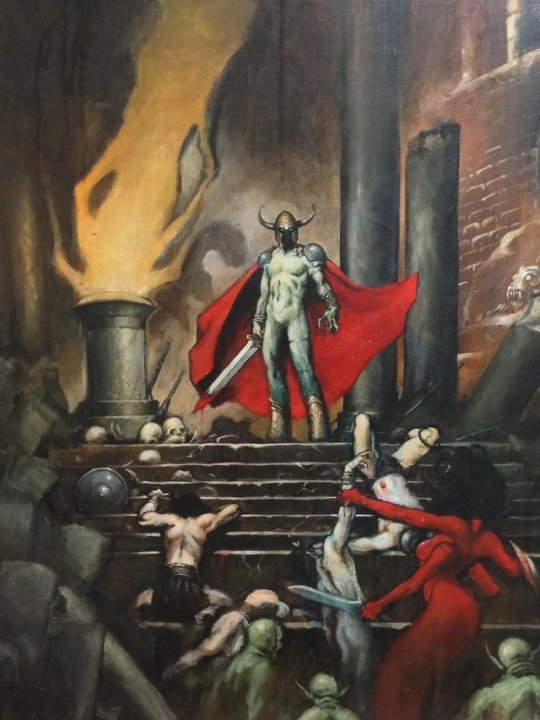

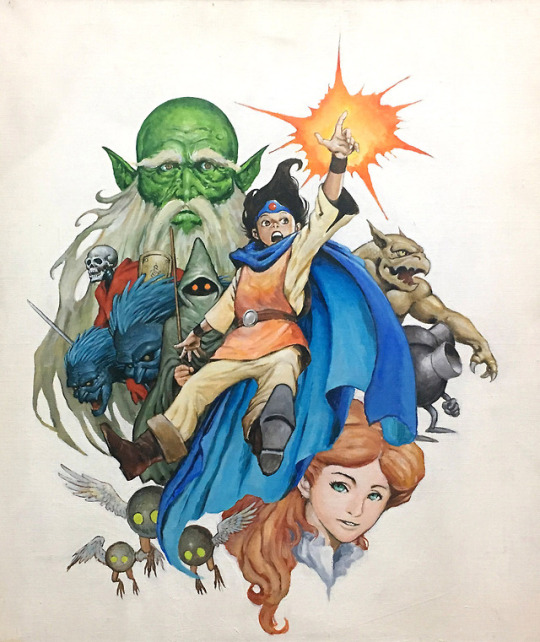




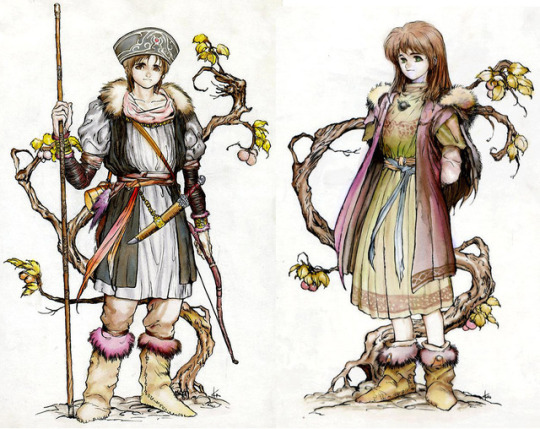


Kensuke Suzuki / 鈴木健介, AKA Hiroshi Kajiyama / 梶山浩 (? - July 12, 2018) Part 1: 1989-1994 Part 2: http://videogamesdensetsu.tumblr.com/post/175911626865/kensuke-suzuki-%E9%88%B4%E6%9C%A8%E5%81%A5%E4%BB%8B-aka-hiroshi-kajiyama-%E6%A2%B6%E5%B1%B1%E6%B5%A9 https://twitter.com/KAJIYAMA_ http://www.pixiv.net/member_illust.php?id=1238858 http://www.hqsweb.com/ https://web.archive.org/web/20000919194756/http://www.cyborg.ne.jp:80/~hq_hp/ https://enty.jp/hqs_kajiyama https://h-kajiyama.tumblr.com/
Kensuke Suzuki started his career in the 80s as an illustrator, designing cover art and illustrations for games, tabletop RPGs and magazines such as Warlock. In parallel with his Western-influenced style --he took inspiration from artists such as Frank Frazzeta and Jeffrey Catherine Jones -- he developed another style in the early 90s and signed these works under a different name: Hiroshi Kajiyama. He used both names in his early years in the video game industry (where he also worked as a graphic designer), then signed all of his works Hiroshi Kajiyama. He directed the video game company Rit's under what (GDRI and) I assume is his real name: Kensuke Suzuki.
He is mostly known in the West for his work on the Shining Force series but also worked on games such as Golden Sun as a chara-designer (the character illustrations were made by Shin Yamanouchi). He worked on a lot of adult games and illustrated many erotic mangas (one of them has been published in France earlier this year). On July 14, 2018, his son posted a message on Twitter saying that his father passed away. He was working on the manga Curse Blood as well as on a comic based on the Chinese game The Soul of Hunter. Games featured above: 1) Dark Wraith / ダークレイス (PC-98 - 1989) cover art 2) Dragon Warrior II (NES - 1990) cover art 3) Wardner no Mori / ワードナの森 (Mega Drive - 1991) cover art 4) Cyber Dodge / サイバードッジ (PC Engine - 1992) cover art, chara design 5) Dragon Master Silk - Ryuu Shoukan Musume - Episode II / ドラゴンマスターシルク~龍召還娘~ Episode2 (PC-98 - 1992) cover art, planning, scenario, chara-design, graphic design 6) Shining Force Gaiden / シャイニング・フォース外伝 遠征・邪神の国へ (Game Gear - 1992) cover art, chara-design 7) Shining Force Gaiden: The Sword of Hajya / シャイニング・フォース外伝II 邪神の覚醒 (Game Gear - 1993) cover art, chara-design 8) Moldorian / モルドリアン (Game Gear - 1994) cover art, illustrations, chara-design 9) Stronghold ~Kōtei no Yōsai~ / ストロングホールド ~皇帝の要塞~ (PC-98, FM-Towns - 1994) cover art 10) Shining Force CD / シャイニング・フォースCD (Mega-CD - 1994) JPN cover art
Games he has worked on: Blue Garnet / ブルー・ガーネット (PC-98 - 1994) illustrations Chō Heroin Senki / 超ヒロイン戦記 (PS3, PS Vita - 2014) chara-design (K-86X) Cyber Dodge / サイバードッジ (PC Engine - 1992) cover art, chara design Dark Wraith / ダークレイス (PC-98 - 1989) cover art Darkness Again (Windows) cover art, illustrations, chara-design Dragon Master Silk - Ryuu Shoukan Musume - Episode II / ドラゴンマスターシルク~龍召還娘~ Episode2 (PC-98 - 1992) cover art, planning, scenario, chara-design, graphic design Dragon Master Silk / ドラゴン マスター シルク (Saturn - 1995) cover art, planning, scenario, character design Dragon Master Silk II / ドラゴン マスター シルクII (PC-98 - 1995) cover art, planning, scenario, chara-design, graphic design Dragon Master Silk 1&2 / ドラゴン マスター シルク1&2 (Windows - 2002) cover art Dragon Warrior II (NES - 1990) cover art From the Darkness ~Injuu Genmu~ / from The Darkness ~淫獣幻夢~ (Windows - 2002) cover art, illustrations Injuu Genmu 1&2 / 淫獣幻夢1&2 (Windows - 2000) cover art, illustrations Injuu Genmu III: Nasty Angel / 淫獣幻夢III~Nasty Angel~ (Windows - 2001) cover art, illustrations Magicians Dead / マジシャンズデッド (Arcade - 2016) enemy design Moldorian / モルドリアン (Game Gear - 1994) cover art, illustrations, chara-design Ōgon no Taiyō: Hirakareshi Fūin / 黄金の太陽 開かれし封印, AKA Golden Sun (GBA - 2001) chara-design (with Shin Yamanouchi), enemy design Ōgon no Taiyō: Ushinawareshi Toki / 黄金の太陽 失われし時代, AKA Golden Sun: The Lost Age (GBA - 2002) enemy design Ōgon no Taiyō: Shikkokunaru Yoake / 黄金の太陽 漆黒なる夜明け, AKA Golden Sun Dark Dawn (DS - 2010) chara-design (with Shin Yamanouchi), enemy design Queen's Gate ~ Spiral Chaos ~ / クイーンズゲイト〜スパイラルカオス〜 (PSP - 2011) Last boss design, CG Queen's Blade ~ Spiral Chaos ~ / クイーンズブレイド〜スパイラルカオス〜 (PSP - 2009) middle boss design, in-game illustrations Raika ~Kasenkyuu~ / 蕾花 ~花仙宮~ (PC-98 - 1994) illustrations Shining Force CD / シャイニング・フォースCD (Mega-CD - 1994) JPN cover art Shining Force Gaiden / シャイニング・フォース外伝 遠征・邪神の国へ (Game Gear - 1992) cover art, chara-design Shining Force Gaiden: The Sword of Hajya / シャイニング・フォース外伝II 邪神の覚醒 (Game Gear - 1993) cover art, chara-design Shining Force Gaiden: Final Conflict / シャイニング・フォース外伝 ファイナルコンフリクト (Game Gear - 1995) cover art, chara-design Shining Force III Scenario 1: Ōto no kyoshin / シャイニング・フォースIII シナリオ1 王都の巨神 (Saturn - 1997) chara-design (with Shin Yamanouchi), enemy design Shining Force III Scenario 2 ~Nerawareta Miko~ / シャイニング・フォースIII シナリオ2 狙われた神子(Saturn - 1998) chara-design (with Shin Yamanouchi), enemy design Shining Force III Scenario 3: hyōheki no jashingū / シャイニング・フォースIII シナリオ3 (Saturn - 1998) chara-design (with Shin Yamanouchi), enemy design Shining Wisdom / シャイニング・ウィズダム (Saturn - 1995) cover art, illustrations Stronghold ~Kōtei no Yōsai~ / ストロングホールド ~皇帝の要塞~ (PC-98, FM-Towns - 1994) cover art Sugoventure: Dragon Master Silk Gaiden / すごべんちゃー 〜ドラゴンマスターシルク外伝 (Saturn - 1998) cover art, graphic design The Darkness (Windows) cover art, illustrations, chara-design Wardner no Mori / ワードナの森 (Mega Drive - 1991) cover art
unreleased Dungeon crawler To be confirmed: Fire Emblem Fates: Birthright (2015) Movie Facial Supervisor Fire Emblem Fates: Conquest (2015) Movie Facial Supervisor Mahjong Princess Go! Go! / 麻雀プリンセスGO!GO! (PC-98 - 1995) Sword Art Online: Lost Song (2015) Tokyo Mirage Sessions ♯FE (2016) Animation Supervisor
Other video game related works: Dragon Quest II: Rondarukia no Akumu (dōjin) Last Chronicle / ラストクロニクル (TCG - 2013) Card Illustrations, developed in parallel with Last Chronicle Online Logout Table Top RPG Special / ログアウトTRPGスペシャル (Magazine - March 1993) cover art The Soul of Hunter / 猎魂觉醒 (comic - 2018) based on an eponymous Chinese game Sources: Pen Name https://twitter.com/daza_e5656/status/499435833938550784 Rit's (company) http://gdri.smspower.org/wiki/index.php/Rit's Passed away on July 12, 2018 https://twitter.com/dankanemitsu/status/1018072446014877696 Frazetta https://twitter.com/KAJIYAMA_/status/486427966780346368 Step by step illustration https://twitter.com/KAJIYAMA_/status/852599238726868992 https://twitter.com/KAJIYAMA_/status/852599348059713536 unknown https://twitter.com/KAJIYAMA_/status/869865392981721088 https://twitter.com/KAJIYAMA_/status/470937986779983872 https://twitter.com/KAJIYAMA_/status/855978184663105536 unreleased Dungeon crawler https://twitter.com/KAJIYAMA_/status/853293499419992065 https://twitter.com/KAJIYAMA_/status/485489965426835456 https://twitter.com/KAJIYAMA_/status/868592737519403009 https://twitter.com/KAJIYAMA_/status/799219419012419584 Unused characters https://twitter.com/KAJIYAMA_/status/802115509021863936 https://twitter.com/KAJIYAMA_/status/802115403019218944 iOS game https://twitter.com/KAJIYAMA_/status/900823156117602304 https://twitter.com/KAJIYAMA_/status/868592657483808768 https://twitter.com/KAJIYAMA_/status/868592431272296448 https://twitter.com/KAJIYAMA_/status/741418739938140160 Saturn game https://twitter.com/KAJIYAMA_/status/892742275125526531
Blue Garnet: A-WORKS, via: https://e-hentai.org/g/198031/6d68e27f6c/ Chō Heroin Senki http://dengekionline.com/elem/000/000/811/811750/ Cyber Dodge https://twitter.com/gdri/status/983474739372060672 Curse Blood (manga) https://twitter.com/KAJIYAMA_/status/887651441900310529 Dark Wraith https://twitter.com/KAJIYAMA_/status/980133594667495424 Darkness Again https://www.suruga-ya.jp/product/detail/ZHOI9939 Dragon Master Silk https://twitter.com/i/web/status/923177684062035969 https://twitter.com/KAJIYAMA_/status/988828174539603968 https://twitter.com/KAJIYAMA_/status/989489235886465025 https://twitter.com/KAJIYAMA_/status/989486473429708800 https://twitter.com/KAJIYAMA_/status/980111302461804550 https://twitter.com/KAJIYAMA_/status/470925412541812736 https://twitter.com/KAJIYAMA_/status/584753498929016833 https://twitter.com/KAJIYAMA_/status/1009509104367251456 Dragon Master Silk Gaiden https://twitter.com/KAJIYAMA_/status/947753116694233090 Dragon Quest II: Rondarukia no Akumu http://www.hqsweb.com/Trial/DQ2_BOR_sample.PDF https://twitter.com/KAJIYAMA_/status/841210782431903744 https://twitter.com/KAJIYAMA_/status/841210881593630720 https://twitter.com/KAJIYAMA_/status/848210024576950272 https://twitter.com/KAJIYAMA_/status/848210218693480448 https://twitter.com/KAJIYAMA_/status/848215746207399936 https://twitter.com/KAJIYAMA_/status/848215907516137473 Dragon Warrior II https://twitter.com/KAJIYAMA_/status/980164041891971072 HQ's A-works (dojin) http://g.e-hentai.org/g/198031/6d68e27f6c/ Half Quarter Book One (dojin) http://g.e-hentai.org/g/718345/3bb6b0961e/ https://twitter.com/KAJIYAMA_/status/947776764259975168 Injuu Genmu series: RB Works (1) via: https://e-hentai.org/g/192515/e0cfd90fc1/ Last Chronicle http://www.last-chronicle.jp/cardsearch/result.php?q%5Billustrator%5D=梶山浩 https://twitter.com/KAJIYAMA_/status/865543558157049857 https://twitter.com/KAJIYAMA_/status/825055980580855809 https://twitter.com/KAJIYAMA_/status/825055863895240705 https://twitter.com/KAJIYAMA_/status/753880198660009984 https://twitter.com/KAJIYAMA_/status/753880717516353536 https://twitter.com/KAJIYAMA_/status/675257570785812480 Logout March 9, 1993 https://twitter.com/kajiyama_/status/486126186192326657 https://twitter.com/kajiyama_/status/486126186192326657 Magicians Dead http://www.comic-ryu.jp/_curseblood/ Moldorian https://twitter.com/KAJIYAMA_/status/978970127696674816 Ōgon no Taiyō series: in-game credits Queen's Blade ~ Spiral Chaos http://www.comic-ryu.jp/_curseblood/ Queen's Gate ~ Spiral Chaos http://www.comic-ryu.jp/_curseblood/ Raika ~Kasenkyuu~ : RB Works (2) Raika, via https://e-hentai.org/g/39012/c9da25455b/ Role Playing Game no tatsujin https://twitter.com/KAJIYAMA_/status/992199653041963008 Shining Force Gaiden series: in-game credits, Half Quarter Shining Force CD: in-game credits, Half Quarter Shining Force III https://twitter.com/KAJIYAMA_/status/955650811513614336 https://twitter.com/KAJIYAMA_/status/955649701331714048 Shining Force III.2 https://www.shiningforcecentral.com/?p=artwork&id=sf3sc2 Shining Force III.3 https://www.shiningforcecentral.com/?p=artwork&id=sf3sc3 https://twitter.com/KAJIYAMA_/status/955650811513614336 https://twitter.com/KAJIYAMA_/status/955649701331714048 Shining Wisdom https://www.shiningforcecentral.com/?p=artwork&id=sw https://twitter.com/KAJIYAMA_/status/892035809112506368 https://twitter.com/KAJIYAMA_/status/892038015203201027 https://twitter.com/KAJIYAMA_/status/892038115111469056 Stronghold ~Kōtei no Yōsai~ https://twitter.com/KAJIYAMA_/status/992200136490082305 The Darkness https://www.suruga-ya.jp/product/detail/ZHOI9939 The Soul of Hunter https://mp.weixin.qq.com/s/K194EJ1MkSzM2FnjciDg2A Wardner https://twitter.com/KAJIYAMA_/status/992199653041963008 Warlock http://doublecrown.under.jp/gamebook/introduction/4-390-80010-8.html http://doublecrown.under.jp/gamebook/introduction/4-390-80012-4.html
355 notes
·
View notes
Text
Tokyo Mirage Sessions #FE review
I said I would give my impressions on #FE and I neglected to do so till now, but better late than never.
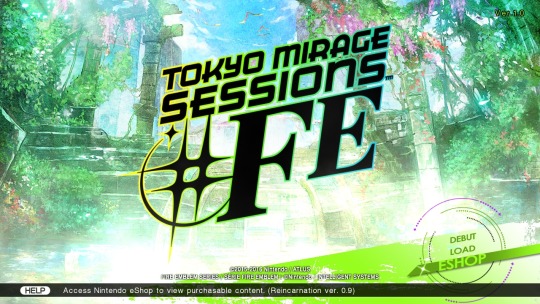
I’ll be talking about:
Story
Setting/Theme
Characters
Gameplay
1. Story
The story is nothing special - I enjoyed it, but it's a fairly typical jrpg "power of friendship and bonds" deal that is only made unique in any capacity by the idol culture that frames it. It's not bad, but it's not groundbreaking either. I wish the story were a bit longer to give more of a build up into the final confrontation. The earlier stages slowly start to set things up but even just one more dedicated chapter to ease into the final arc would have probably made the ending feel less rushed. That and I just enjoyed playing it overall and would liked more content.
The distinct chapters format to the flow may have been meant to simulate FE chapters while still also representing how persona stories often have noticeable breaks between dungeon arcs. In TMS though, it felt a bit more artificial, not damningly so, but I think the plot momentum was a bit worse for it.
The set up for each chapter break also revolves around Itsuki himself improving as an entertainer, even though he doesn’t know what direction he wants to focus on, and while it’s most emphasized early on, this aspect of Itsuki’s development himself feels almost abandoned or ignored through the mid and late game until the very end. The solution does make some sense, but some of the details that enable it to happen are a bit questionably contrived, and like the overall story, it felt a bit rushed in the final hour, based on what I remember.
Otherwise, the story did a good job of setting itself up, providing the characters with adequate motivation and means to seek the goals they set and each dungeon gave reasonable purpose for the main characters to tackle it.
The final chapter seemed to be trying to make up for the lack of build up by twisting and turning a bit more than usual, but most of its attempted twists were fairly standard fair for trying to draw out suspense and unfortunately were somewhat predictable for it. I was a little surprised at the host for the big bad, but mostly because I hadn’t been paying close enough attention so that was on me.
2. Setting/Theme

The Tokyo idol scene setting is the most interesting aspect of the story and while I can see it being polarizing, I found it novel myself. Mechanically, it does a good job of unifying the dungeons under a common theme of "things idols do" - such as posing for photo shoots or acting on TV.



Beyond dungeon design, the idol theme also naturally informed character designs and the multitude of costumes that appear throughout.



You can even see this thematic flair in the way that spell casting involves a character signing their autograph as a glyph!

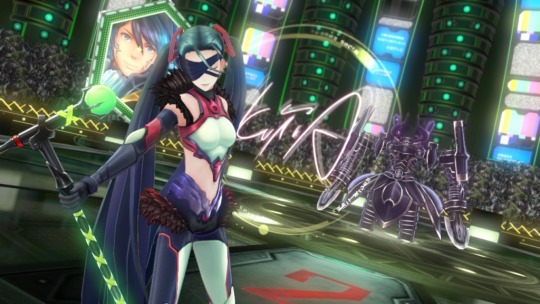
If there’s one oddity that stands out to me about the aesthetics of the game, it’s that the monster designs seem to be unable to decide whether they should be FE inspired or SMT inspired or neither, but even in the latter case most don’t seem to fit in with the idol theme in any capacity.
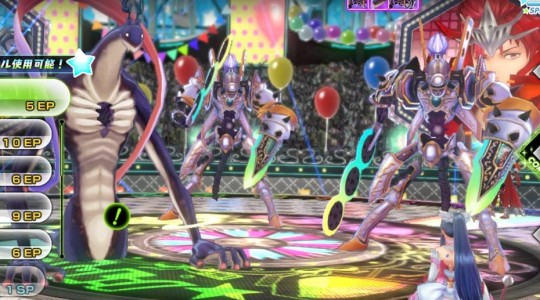
Even when enemies are FE inspired, they seem to have gone through a similar (if not more extreme) filter that the Mirage characters went through - becoming dramatically stylized and the only real purpose I can conceive for it is to make enemy classes that were definitely human in FE appear non-human here. For instance, the middle and right monsters above are myrmidon class enemies - unpromoted swordmasters from the FE universe.
Not to mention: Why do their out-of-combat sprites look like Organization XIII members!?

3. Characters

Like the story, the characters are good if nothing particularly revolutionary. Most seem built around one or two tropes but then are fleshed out beyond that which is fine. You learn more about them as you do their individual side quests (social links) and these do a good job of giving the feeling of evolving your bond with that character. The pacing of the side stories is mostly okay, though the gameplay reward for those that are plot locked to be very late doesn't always feel equal to how long you had to wait to do them. There's a bit of persona syndrome wherein all the chars get plenty of opportunities to interact with the MC, but would benefit from more time interacting with each other as well.
I liked all the characters in the end. There's a good variety between both the girls and boys, though because of join times some chars got more focused screen time than others. Again, I think a longer late game with more story side quests (instead of fetch quests) would have helped balance things out.
If I had to be as base as to rank the girls in terms of waifu ratings: 1. Eleonora 2. Tsubasa 3. Kiria 4. Maiko 5. Mamori = Tiki Though it's worth noting that top four are all really close, and each slot only wins out over their competition by a small margin. I don’t dislike Mamori or Tiki, I just am not into the little sister appeal.

I suppose Barry Goodman is worth mentioning as well. Barry is a foreigner who settled in Japan and behaviorally embodies the most cringe-worthy aspects of otaku culture. He’s heavy-set, roughly groomed, and somewhat aggressive/abrasive about his passions. I’m not one to judge him for the subject of his passions, but the way he interacts with them would make me uncomfortable around him had he been a real person. Ultimately he is a good person at heart, but his poor people skills are unlikely to endear him to anyone on first impressions, and the fact that he doesn’t care only exacerbates his problems.
Finally, and predictably most disappointingly, the FE chars (heroes and villains) are barely developed and could be replaced with persona or persona like motifs without changing the overall plot. The FE aspect is little more than a coat of paint that gives secondary theme to the invading 'otherworld,' and it's a real shame and waste of potential.
Aside from the Mirage characters and Tiki themselves, there are however a few unmarked references that are at least self aware enough to be welcome Easter eggs for fire emblem fans:

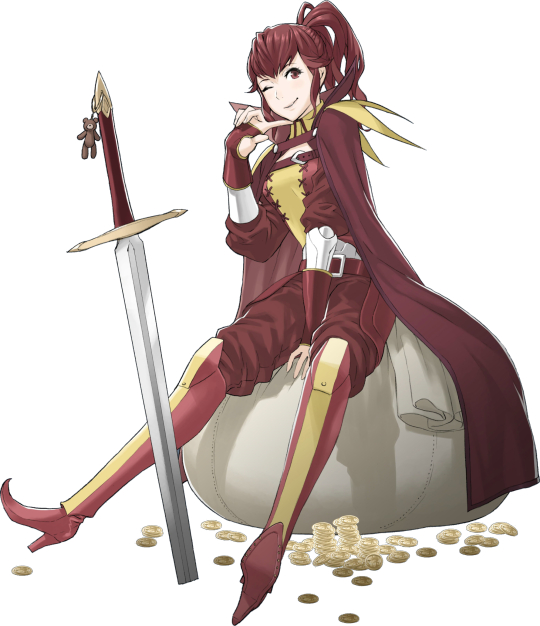
Anna is your convenience store shopkeeper, and there’s even a ‘shadow anna’ who will sell you more dubious dungeon consumables that a normal convenience store wouldn’t stock.

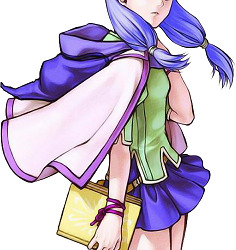
Ilyana works at the cafe, keeping close to her beloved food.
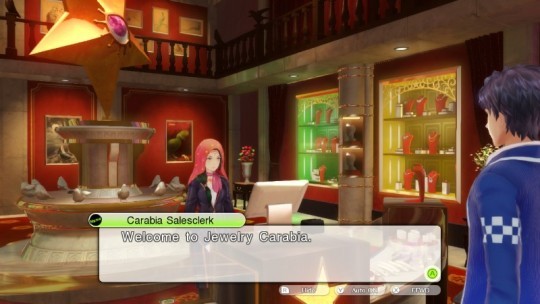
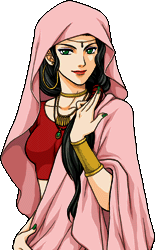
Aimee runs the jewelry store as she was the item store merchant in FE9 and 10
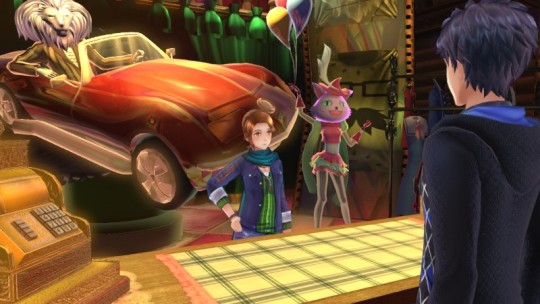

And Cath runs the costume shop. She’s a thief in FE6 with a distinct affinity for money, not unlike Anna, though not as extreme either. Admittedly, it’s been a while since I’ve read over her supports though.
I saw an npc employee at one of the random background shops in Shibuya central street that could also be Brady from FE Awakening, but the camera never got close enough to see him clearly enough to make a positive ID.
Finally, I found it amusing that all the playable chars' names are class puns/references
蒼井樹 = Aoi Itsuki > Aoi means blue in reference to FE lords typically having blue hair
織部つばさ = Oribe Tsubasa > Tsubasa in reference to her peg knight class
赤城斗馬 = Akagi Touma > 赤 (Aka) gives us “red” while 馬(uma) is “horse.” Red cavalier (partnered with a green cavalier) is a reoccurring archetype in FE. The Red cav tends to be the hot-headed one.
I can break down the others if desired, but these will do for examples.
4. Gameplay
Going to break this into a few parts:
General
Combat
Dungeons

1. General
The real reason this game is compared to Persona; gameplay mirrors a lot of persona's elements and it's almost easier to describe how it deviates from the Persona format than spend time detailing how they're the same. That said, if you like the persona formula (as I do), you'd probably enjoy TMS's gameplay flow as well.
While the lack of daily life and day limits for dungeons removes a lot of the tension of time management for them, I think it's fine since a lot of persona players rush dungeons in 1-2 days anyway and in TMS, once the dungeon is done, you don't have to worry about doing busy work to tick off the days until the plot is allowed to move forward again. The lack of social stats is an element of depth removed, but without a time cost element to activities, it makes sense and is probably a good thing for it to be absent from TMS (even if story wise it could have actually be viable as Aoi and the others grow their skills as performers).
Using the WiiU game pad as a smartphone screen to facilitate off-screen character interactions as well as display more detailed enemy information was clever if perhaps unnecessary (as persona 5 showed). Having the only map on the game pad actually made it a little disorienting to reference for me since my eyes had to leave my tv entirely, leading to me either holding my game pad up or bobbing my head up and down to compare my map with my surroundings. On the DS, the two screens are at least close by. I’d like to say there may have been a better use for the game pad, I’m not thinking of anything off the top of my head, so it may have been wise to minimize its use as a gimmick anyway.



This is already in your phone history when you start the game, but it’s still probably my favorite moment from the text message logs:
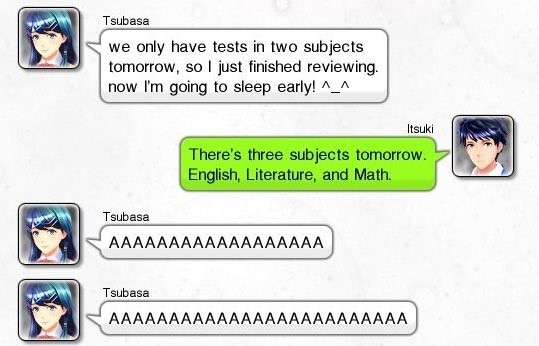
#relatable.
Replacing persona fusion is a more straightforward crafting system that is the source for your weapons and passive skills, and in turn, much like Tales of Vesperia, your weapons are the source of your skills, both active and passive. The system sounds more grindy than it is in practice though. Simply advancing through the dungeons and fighting 70-80% of the monsters you encounter naturally will provide you with enough materials to forge most weapons as they become available. In fact there were a number of times when I ran out of new weapons to forge and had to push on with already mastered weapons equipped. I liked that bosses and some savage encounters would drop mats of a higher tier than what was readily available from current monsters, and you had to spend them wisely before advancing the plot to the point where those mats became common. It let you preview the next tier of weapons and abilities for select characters but who you gave those weapons to was never overly stressful since you could get the other weapons you passed on later anyway.
Rare monsters drop unique mats that can make weapons that give unusual or otherwise off-type skills to characters and it makes catching rare monsters that flee rather than engage the player rewarding. IIRC, I encountered fewer than ten rare monsters in my entire play through though, so I did not feel it worth the time to actively hunt them unless there was some trick to make them appear more reliably (and catching them was also a bit dependent on the surroundings). Like treasure monsters in P5, they usually had some kind of gimmick where they were only weak to one thing if they had any weakness and the latter ones also came with dodge [weakness] passive and had a chance of just up and running from battle.
2. Combat
The one-more mechanic is replaced by "Sessions" which are not unlike self contained one-more combos anyway. The tag in attacking animations were pretty fun and though late game sessions can get quite long, there’s no way to speed up or skip session animations, possibly in part because of the existence of duo arts which use the session animations as a timer. They could have prohibited skipping prior to deciding on a duo art and then allow skipping or speed up after, though. Long session animations didn’t bother me, personally though, as session attack animations were varied and interesting enough that I never got tired of even the early basic ones (most of which were replaced by late game).

Openly displayed turn order, plus some late game skills that can actually influence turn order were both welcome features as well.

Beyond sessions, specials, duo arts, and ad-lib performances were great at providing extra variety and changing the pace of what might otherwise be rote combat. While duo arts and ad-lib performances were rng bonuses that you mostly just take whatever you can get and be grateful, specials were more deliberate, needing a resource that builds slowly at first. Later on, with longer sessions and meter boosting passives, the sp gauge builds up much faster, but even then specials usually should be selected carefully, especially within boss battles where recovering lost sp is a bit trickier.
That said, special skills were not created equal. Even though buffs and debuffs are powerful, some of the later buffing and debuffing specials came late, at a point where I already had normal skills that could buff or debuff at almost if not the same potency without spending SP. Similarly, as my repertoire of skills grew, my ability to hit weaknesses improved and using specials to break through resistances became less necessary, even as monsters began appearing with more resistances.
Finally, Itsuki’s second special - “Strike A Pose,” was absurdly good and only got better as my session combos grew longer late game. The ability to give everyone twice the actions in a turn opens up so many other combos that often times, there was little reason to use offensive specials in favor of either two individual sessions or a concentrate/charge boosted session.
Inversely, I found myself using healing specials a lot less, and perhaps it was because I used Tsubasa a lot less late game - I made Chrom a great lord which gave Itsuki healing and support which was kinda Tsubasa’s niche previously, so with Touma able to out damage Tsubasa and Elly covering flying enemies, Tsubasa just wasn’t out in combat all that often, which meant Mamori was the only one with healing specials (which were helpful on occasion) but in the end using Strike A Pose allowed me to get normal heals out in extra abundance while still enabling attackers to make a play to help clear troublesome enemies.
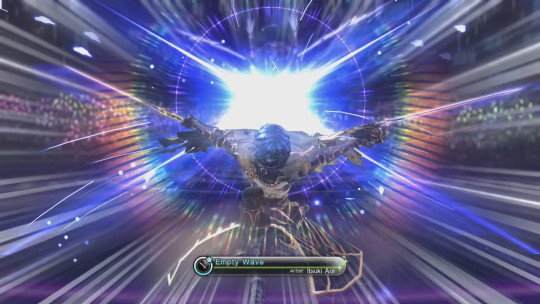
The FE weapon triangle’s representation in strengths and weaknesses among weapon types (not extending to magic though) gave a welcome way to predict weaknesses for enemies I had not encountered yet. One of the frustrating things about persona had always been that weakness/strength attributes for new monsters were difficult to predict and late game could cause you to walk into a bad situation that was never really your fault. Not only did the weapon triangle help mitigate some of the arbitrary mystery, but weaknesses were frequently consistent across similar enemy types at different levels even outside of the sword/lance/axe trinity. For example mage type enemies were, with few exceptions, all weak to swords and fire. Skills that deal effective damage (i.e. horseslayer/armorslayer) were also a great addition that gave characters tools to start session combos on enemies that they might otherwise be powerless against. The player also gets other ways to work around pesky resistances, features that are both welcome and necessary because...
If I have one glaring critic of the battle system it’s that Itsuki, like persona protags is mandatory. However, unlike persona protags, Itsuki has static combat tools and extremely limited ability to influence his own strength and weakness attributes. He’s always weak to fire and lances and since you can’t remove him from the front line, you always have someone in combat weak to those elements. Fortunately this is less deal breaking for the fact that Itsuki dying in combat doesn’t immediately game over (hallelujah!). In addition, later in the game most chars get passive skills that greatly increase their avoid against elements they’re weak to, Itsuki included. Still, being able to remove Itsuki from the front line would greatly increase your party diversity and flexibility. For a while after recruiting a second sword character, I had difficulty justifying putting him in the active party because Itsuki already filled the sword role. Eventually, I promoted Itsuki to a more support role and let the other char handle offensive sword plays.
One more minor complaint I have is the inability to swap out fallen allies. Having only three party members means that even one of them dying can be crippling, especially later on and on harder difficulties. I’ve wasted turns reviving downed allies and trying to heal back only for enemies to just repeat what killed someone in the first place and put me exactly where I was last turn with less healing items or sometimes in an even worse situation. While the boss dichotomy of easy/impossible with little in between that some persona bosses suffer from is present here, the existence of specials, ad-lib performances and duo performances that heal or revive greatly alleviate some of the comeback struggle that has a tendency to snowball in this combat system. As the only active non-rng option, specials in particular are important to the system. The severity of boss gimmicks isn’t quite as punishing in TMS compared to persona, but TMS’s smaller party size, can still cause a bad situation to cascade into unsalvageable territory.
3. Dungeons
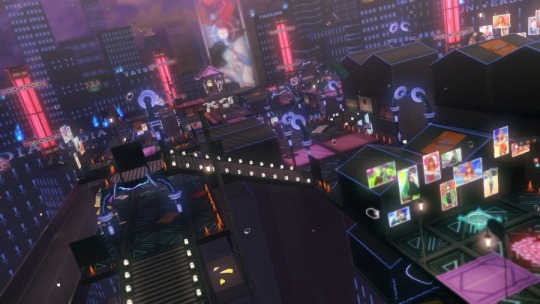
The dungeon design of TMS is interesting in that it departs from persona 3/4′s formula of randomly generated floors in favor of deliberately organized floor plans with usually only one correct path to the end. The linearity is sometimes broken up by treasures that you’ll have to backtrack for, but aside from that, there’s little mandatory backtracking within a dungeon. Dungeons stick around even after you clear them, allowing side stories to ask you to venture back over familiar ground for one task or another.
That said, the linear nature isn’t necessarily a bad thing. In TMS’s case, it allows the developers to give the player a learning curve for the dungeon’s mechanics and then challenge how well the player understood the earlier lessons, because the devs can guarantee that the player experienced the earlier sections before the later ones. It may sound obvious on paper, but it means that the developers can have a better awareness of the player’s competency at any given point in any dungeon, which is something that can’t be tracked when the player can go multiple routes at any given time. But I digress.
Another mechanical difference of note is how the player, Itsuki interacts with enemies pre-battle. In persona 3 and later, you could swing your weapon to hit an enemy in the field and that would start combat (at an advantage if they didn’t notice you), but in TMS, striking an opponent on the field knocks them back and stuns them, giving you the choice to then get closer and touch them to begin combat at an advantage or to avoid combat entirely. I like this greater degree of choice and it fits within the philosophy that TMS dungeons are made to be less stressful - less about meticulous resource management - than persona games. There’s still an incentive to engage in combat: you need to keep up a certain amount of level growth just to have the raw stats to beat bosses, but if you’re low on health and/or healing items or just plain short on available play time and you think or know there’s a checkpoint up ahead so you just want to make a push to reach it, you aren’t forced into battles you don’t want to engage in... with the exception of “Savage Encounters,” which are challenge monsters that seem to just exist to screw with you anyway. I think there was only one area prior to the last or second to last dungeons that had savage enemies I could actually beat albeit with great effort.
Playing TMS after Persona 5, it was also apparent that TMS’s idolaspheres were prototype palaces, from the set floor layouts and linear progression to the overarching themes of the dungeon informing its aesthetic and unique mechanics. In fact there are a number of things that TMS pinoeered for Atlus that then went on to feature in P5. You can read about some others here.
Puzzles were almost entirely navigation in nature - that is, how to use the dungeon mechanics and infrastructure to get from your start to your goal. It may be because it’s been a little over a month now, but none particularly stand out in my memory as being exceptionally good, while one or two I remember for being somewhat arduous or tiring. I’m still of the opinion that areas that the player is trying to solve puzzles in should have lower if not 0 encounter rate with random enemies, as battles, especially turn based ones that don’t tend to resolve in a single turn, can disrupt problem solving trains of thought.
Overall the dungeons are good though, and that’s important as they’re the meat of the gameplay. They are generally well paced with plenty to do and some minor stuff to find on your way to your target goal. Each dungeon’s unique mechanics fit with the dungeon theme and aside from a few exceptions the enemies are fairly distributed.
5. Conclusion
It has its flaws but I think, in the end, Tokyo Mirage Sessions #FE gets more right than it gets wrong. Even though the story was standard fair for this genre, I thoroughly enjoyed it and wished it had more content to its core for me to experience. I know there’s dlc, but the nature of dlc means that it’s nothing integral to the story and I’m not sure it would scratch the itch the way I want.
The setting is unique and the game fully embraces the themes it sets up and the themes in turn inform and affect almost every aspect of the game, giving it a unified appeal.
The combat is arguably more interesting than persona. It takes the same core formula of targeting weak points for massive damage but allows players more tools and freedom to circumvent bad matchups, make carefully planned strategic plays, or simply style on enemies with flashy satisfying attacks.
2 notes
·
View notes
Text
20 Games I Loved in 2016
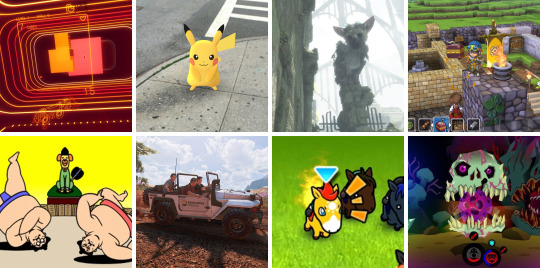
The Switch delay. Several big AAA duds. Another year without an official Mother 3 U.S. release. 2016 could have been a disappointing year. (Outside of video games, it certainly took its toll.) But at least from my perspective, the good far outweighed the bad. Virtual reality finally made it out of the gates, and despite some hiccups, it shows real promise. Long-delayed games like Final Fantasy XV and The Last Guardian somehow made it to store shelves AND surpassed expectations. And love it or hate it, Pokémon Go inspired a genuine pop culture craze the likes of which we’ve never seen before, at least as far as games go. I think all of that is worth celebrating.
Before we get to the list, some quick shout-outs and no-brainer caveats…
2016 was not kind to the Wii U, but the 3DS quietly had one of its best years ever. That’s partly reflected here, but I couldn’t make room for Dragon Quest VII, Fire Emblem Fates, BoxBoxBoy!, Metroid Prime: Federation Force and Gotta Protectors, to name a few. Sometimes it felt like Nintendo was just cleaning out its closet — how long ago was DQVII released in Japan? — but we benefited either way.
Overall, I played fewer games this year, but the ones I did play held my interest longer. Thanks to various microtransactions and DLC, 2016 probably hit my wallet just as hard.
What didn’t I play? Stardew Valley, SUPERHOT, Final Fantasy XV (at least past chapter 2), Frog Fractions 2, Hitman — oh, and I didn’t get to stuff from last year like Yakuza 5 or The Witcher 3, either. Yakuza 4 was pretty solid though.
I left off any new ports of games that came out last year or prior, unless there were substantial additions that changed the experience in a meaningful way. That meant The Legend of Zelda: Twilight Princess HD and Mini Metro weren’t in the running, while Rez Infinite technically was.
Love making lists, hate ranking items in said lists, just because I’m incredibly fickle. There’s a good chance that I’ll want to shuffle everything around the moment I publish this. But my podcasting buddies are counting on me here, so it’s time to be decisive.
Keeping all that in mind, here are the games I really loved in 2016…
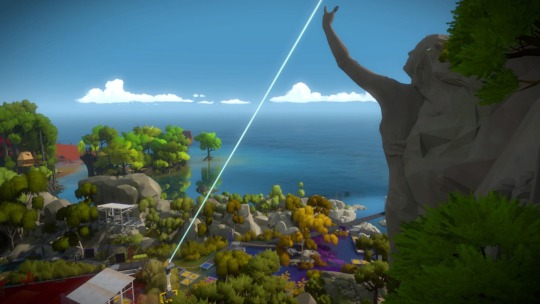
20. The Witness - I’m already cheating because if I’m being honest, I didn’t actually love this game. The Witness takes a couple dozen hours to finish, and I spent at least half of them staring at a notebook, drawing grids, connecting dots, and having no idea how to pave forward. But even if I didn’t love the game, I respect it immensely. I admire Jonathan Blow’s commitment to this singular idea, of taking the kind of puzzle you might see on a restaurant placemat and coming up with every possible permutation of it. And there is of course a “meta” layer on top of that, where solutions to each component change the environment around you — tree top bridges that unfold based on the paths your lines take, or colored glass panels that create new puzzles on top of old ones. It might be cold and off-putting at times, but The Witness is still commendable as the ultimate puzzle box.
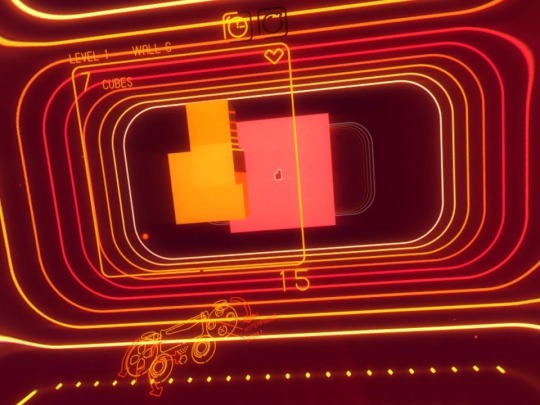
19. SuperHyperCube - I bought into PlayStation VR for games like Rez Infinite and RIGs — big, flashy, “immersive” experiences. And they delivered! I’m a very happy PS VR owner, and I hope Sony builds on its momentum this year. (I’m skeptical, but then being a virtual reality early adopter was always a leap of faith.) However, while I got exactly what I expected from most of the launch titles, it's the simple puzzle game seemingly modeled off of “Brain Wall” that I keep coming back to. I turn on the headset to play Job Simulator or Battlezone, but I always play a couple rounds of SuperHyperCube before I’m done. A solid case for virtual reality not as a thrilling roller coaster, but a hypnotic, relaxing voyage.
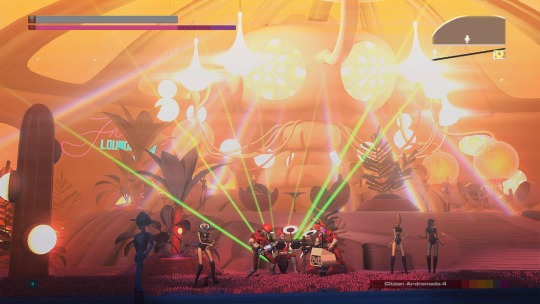
18. Headlander - The best game Double Fine has put out since Iron Brigade. Free-roaming Metroid-style exploration, a perfect 70s-synth sci-fi score and a fun body swapping gimmick at the heart of it all. I wish there were more vessels for your noggin to control, but there’s a strong foundation here.
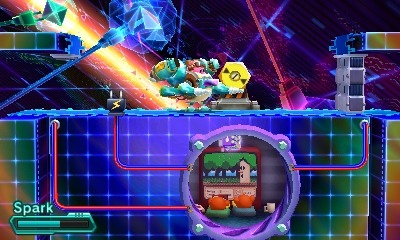
17. Kirby: Planet Robobot - It’s easy to take Kirby games for granted, and that’s especially true of Robobot, which uses the same engine and many of the same powers as the recent Triple Deluxe. What does the former bring to the table then? Smart level designs that take advantage of the new mechs without letting them dominate the action. A novel mechanical world that feels distinct from the typical pastel meadows. New amiibo support. OK, so maybe it doesn’t add that much to the series, but it’s right up there with Super Star anyway.
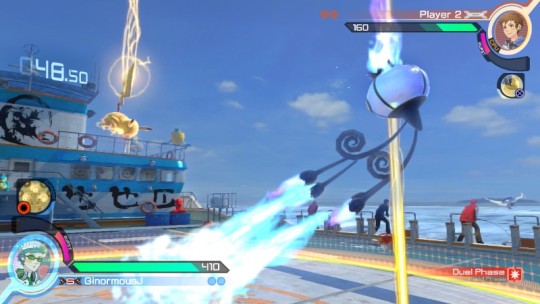
16. Pokkén Tournament - This game is a fresher, more enjoyable fighting game than Street Fighter V. It doesn’t even matter (too much) that the single player is pretty thin or that the roster is small. When’s the last time you played a one-on-one fighting game that felt truly new? Pokkén is a great 3D fighter and a great 2D fighter at the same time, which is no small feat. And it’s also a gorgeously animated recreation of those battles we all imagined happening in our Game Boys 20 years ago.

15. Uncharted 4: A Thief's End - The popular sentiment seems to be that Madagascar is when this final Uncharted entry really takes off. Slow drama and frequent cut scenes give way to island exploration and memorable shootouts. My take? The back half is fun and the epilogue is lovely, but I could spend an entire game in Nathan and Elena’s living room, or hopping around the globe for the next story sequence. Wherever you stand, this is a fine way to close out a reliable series.

14. Picross 3D: Round 2 - Seven Picross games — eight if you count the Twilight Princess freebie — on the eShop. That’s a lot of a perfectly fine thing. But none of them are Picross 3D. Thankfully, the real deal finally arrived this year, with hundreds of puzzles and a few extra gameplay wrinkles. Worth the premium price tag.

13. Titanfall 2 - The campaign didn’t need to be good. Multiplayer FPS games live and die by their multiplayer, and many developers seemingly write off the single player experience as an afterthought. That’s why Titanfall 2 is such an unexpected treat. The factory, the time hopping, the airborne carrier — all cleverly designed, with platforming gimmicks that would feel just as suited for a Metroid Prime game. I think the reason the new Mirror’s Edge fell flat for me was that this game featured the same parkour moves in a much more exciting package.
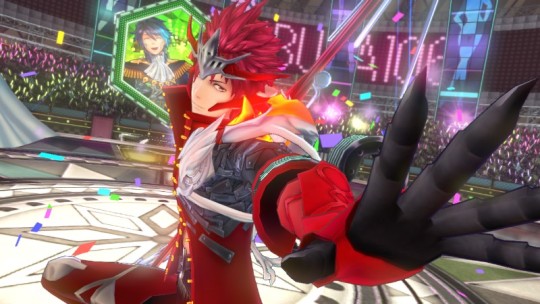
12. Tokyo Mirage Sessions #FE - This crossover game is Persona-lite, yes, but I think that sells the characters and world a bit short. While its inspiration focuses on the pressures of being a Japanese high schooler, #FE is all about the Tokyo show biz scene. Pop music, soap operas, microwave cooking shows — it’s all very goofy, but the game still takes its protagonists’ dreams and ambitions seriously. #FE also makes clever use of the Wii U GamePad, turning it into a tablet/social app that helps keeps the conversations going. Even if you’re not into this particular “scene,” #FE may still win you over.

11. Rhythm Heaven Megamix - I can’t get enough Rhythm Heaven. They could put 20 new musical minigames on a cart annually and it’d make my list every year. Sumo wrestlers, lumberjack bears, monkey slumber parties — all magic.
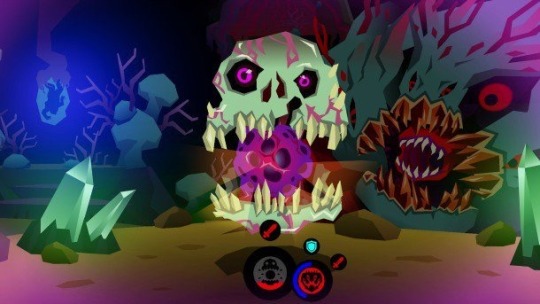
10. Severed - A Vita game! It’s great to see DrinkBox Studios stretch beyond sidescrollers with this first person dungeon crawler full of grotesque monsters and creepy, colorful mazes. Swiping and poking on the Vita’s touchscreen feels great. The controls are key to Severed’s success; if battles were menu-driven, the entire game would fall apart.
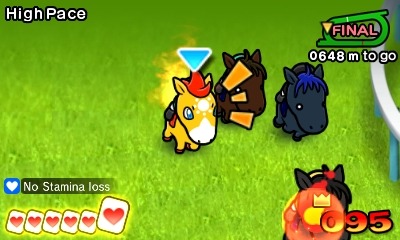
9. Pocket Card Jockey - I hope Nintendo keeps letting Game Freak be this weird. It’s not just that it’s horse racing plus solitaire. It’s your jockey biting the dust and being brought back from the dead to repay his debt to the angels. It’s the brassy, big band score that accompanies every race. It’s horses with luchador masks and cats hanging from their backsides. Pocket Card Jockey is a miracle of localization.
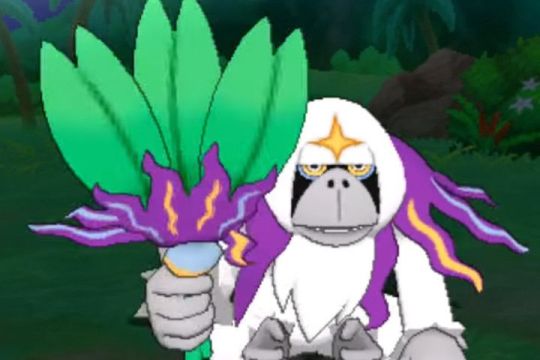
8. Pokémon Sun - Yes, another Pokémon game. The Alola region is the best thing to ever happen to this series. Previous games had regions based on cities like New York and Paris, but the results always felt half-hearted. In Sun (and Moon), the tropical island setting influences everything from the creatures you catch to the trials you complete. I’ve never demanded a believable world from this series, but that’s kind of what we get here, and it’s terrific.
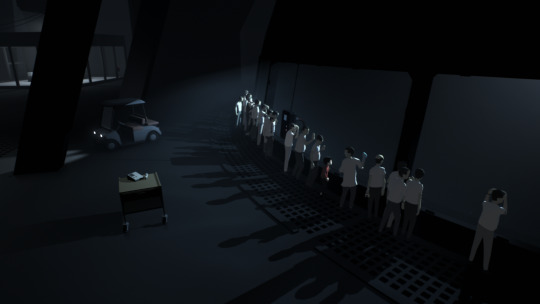
7. Inside - This is the type of game where the less you know going in, the better. It’s Limbo — a previous Justin GotY — filtered through a twisted dream logic that I still can’t get out of my head months later.
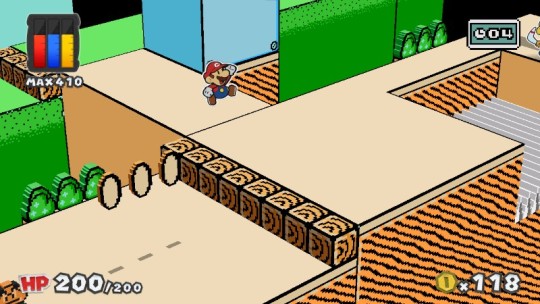
6. Paper Mario: Color Splash - I know you don’t like Sticker Star. Rest assured: that 3DS oddity feels like a rough draft for Color Splash, which improves upon its predecessor in every way. A textured, vibrant world that rivals Tearaway in its papercraft. Thrilling scenarios like a train heist, an underwater game show and the throwback above. Hilarious dialogue that mostly makes up for the many, many identical toads. I miss the liberties Intelligent Systems used to take with the Mushroom Kingdom, but everything else about Color Splash restores this spin-off series to its former glory.
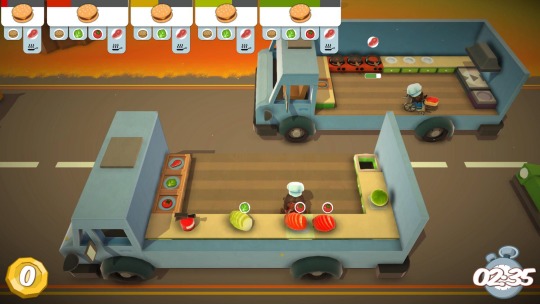
5. Overcooked - This year’s couch co-op champ. Cooking with a partner is all about communication, and that’s doubly true when the kitchen is split across two flatbed trucks or on an iceberg rocking back and forth. My friends and I love head-to-head games like Smash Bros. and Towerfall, but it’s nice to play a game that’s all about puzzle solving and careful planning together. And I love the wistful stage select music.
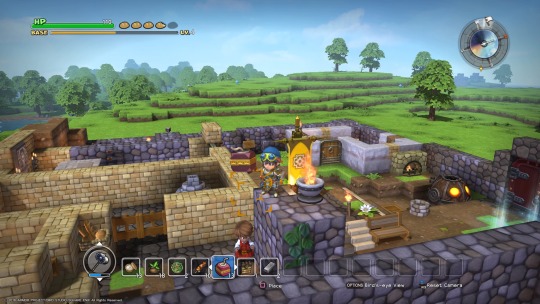
4. Dragon Quest Builders - Minecraft has always fascinated me, but I don’t do well without direction. That’s why I’m so grateful for Dragon Quest Builders, which breaks down the open world construction into small, manageable tasks. I started off just sticking to blueprints and keeping decorations to a minimum; now, I’m spending hours building up towns the way I want them to look, for no other reason than my own personal satisfaction. Even taking the crafting element out of the equation, Builders does a great job of capturing the adventuring spirit of its parent series.

3. Pokémon Go - I didn’t set out to put THREE Pokémon games on here, and in a vacuum, this is much less satisfying than Pokkén or Sun. But we don’t play video games in a vacuum, and certainly not this one. I played Pokémon Go in Central Park, talking to strangers to find out where the Ivysaur was hiding. Or I played on my lunch breaks, exploring parts of South Street Seaport with coworkers that I had ignored for years. Go’s peak came and went, but it remains one of my fondest experiences of the year.
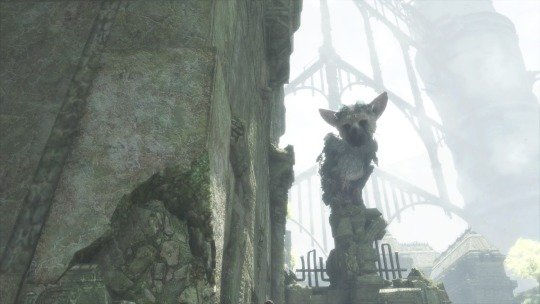
2. The Last Guardian - Another game that’s more than the sum of its parts. The Last Guardian is finicky and sometimes frustrating. Trico is hard to climb. The camera doesn’t know what to do when you’re up against the wall. So what? How many games feature a creature this lifelike? He may be an illusion made up of A.I. routines, scripted animations and fur shaders, but all of those elements come together in a uniquely convincing way. His evolution from reluctant ally to friend has a subtlety I’ve never seen before. I’m glad Ueda spends as much time focusing on the inner struggles as he does the external ones. Hope it doesn’t take another decade for his next game.
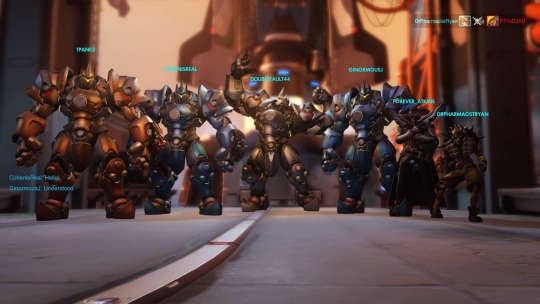
1. Overwatch - I didn’t even know what Overwatch was until two weeks before its release, and even then, I didn’t expect much from it. I had played Team Fortress 2 and thought it was just fine. I knew what to expect. Medics, tanks, builders — that sounded familiar to me. But I was so wrong. Overwatch isn’t just a team-based shooter; it’s the superhero team-up game I’ve been longing for since “The Avengers” was in theaters.
All 23 (and counting!) heroes have their superpowers, and all of them have their jobs to do. What really sets Overwatch apart is when these heroes are bouncing off of each other. Any combination of six is going to have its own dynamics. Mei dropping ice walls to give Reinhardt time to recharge his shield. Junkrat dropping traps to help Bastion watch his back. Mercy gliding up to Pharah to give her rockets a little extra punch. Every battle brings new possibilities and strategies to the table. I’ve played over 100(!) hours and feel like there’s still so much to learn.
But it’s not all serious business either. The colorful personalities, animations, costume designs and more do so much to shape the world, even when I know next to nothing about the overall “lore.” Last year, Splatoon felt like the only shooter I’d ever need, but Overwatch has actually managed to supplant it in my heart. That’s something this Nintendo fanboy never thought he’d say. Can’t wait to see how Blizzard builds on their masterpiece in year two.
3 notes
·
View notes
Text
Earlier today, the official Sakura Wars Twitter account revealed a new cast member for upcoming game Project Sakura Wars (Shin Sakura Taisen). The game will add the following:
Oboro: Daisuke Kishio
Oboro is a high-grade kouma who appeared in the Imperial Capitol with Yasha. He has a high-flying, arrogant demeanor and a generally disillusioned air. His distorted views on the world inspire terror in the population, and he in turn revels in their despair. He specializes in producing illusions, which are conjured up by incredible powers, and brings swift death to those who come at the wrong end of his teeth.
In battle, Oboro commands the puppet soldier Arabaki. Visuals for the character and his craft were also revealed along with a visual for Puppet Soldier Kyokotsu. You can check all three out below.
Oboro
Puppet Soldier Arabaki
Puppet Soldier Kyokotsu
Project Sakura Wars will hit Japanese retailers on December 12. A standard and Limited Edition are both planned for the project. The Limited Edition will include a soundtrack CD set and an artbook. The CDs will feature more than sixty songs from the franchise’s history, while the artbook will contain seventy-two pages of art from the series.
Early adopters will also receive a PS4 theme, though details on this have yet to be announced.
The project will be released worldwide in Spring 2020.
The confirmed voice cast includes:
Claris: Saori Hayami
Hatsuho Shinonome: Maaya Uchida
Seijūrō Kamiyama : Yōhei Azakami
Sakura Amamiya: Ayane Sakura
Azami Mochizuki: Hibiku Yamamura
Anastasia Palma: Ayaka Fukuhara
Sumire Kanzaki: Michie Tomizawa
Reiji Shiba: Tomikazu Sugita
Kaoru Rindou: Yui Ishikawa
Komachi Ooba: Ryoko Shiraishi
Yang Shaolong: Yuuichirou Umehara
Yui Huang: Sumire Uesaka
Arthur: Nobunaga Shimazaki
Lancelot: Manami Numakura
“Yasha”: Chisa Yokoyama
Elise: Nana Mizuki
Margarethe: Rie Kugimiya
Itsuki Saijo: Mayu Yoshioka
Hiromi Hongo: Haruka Terui
Itsuki Saijo: Mayu Yoshioka
Hiromi Hongo: Haruka Terui
Bleach creator Tite Kubo is providing the original character designs, while Jiro Ishii (Nine Hours, Nine Persons, Nine Doors, Under the Dog) is in charge of the story structure. Series composer Kohei Tanaka (Sakura Wars franchise, One Piece, Mobile Fighter G Gundam) is scoring the game’s soundtrack. Other staff members include:
Script: Takaaki Suzuki (Girls und Panzer, Strike Witches)
Setting and Scenario Summary: Takanobu Terada
Development Director: Tetsuya Ootsubo
Producer: Tetsu Kitano
Character Visual Setting: Masashi Kudou
Main Mechanical Designer: Mika Akitaka
Executive Producer: Haruki Satomi
Original Concept: Ohji Hiroi
Project Sakura Wars will be set twelve years after the events of Sakura Wars 5: So Long, My Love. In this new entry, the Combat Revues, which previously protected nations from evil while working incognito, are well known to all.
Indeed, the Great Combat Reveue World War is more of a global sporting event, in which the Combat Revues from across the globe gather in Japan’s Imperial Capital to compete in a tournament. These disparate groups then compete to determine which country’s kouma-crushing corps reigns supreme. By the time Project Sakura Wars begins, two such events have already taken place, and the nations are gathering in the Imperial capital for the third. What should be a peaceful event, though, suddenly takes a turn for the serious.
Sega’s email communication describes the story as:
The stage is set in a romanticized version of 1940s Imperial Tokyo. 10 years ago, a cataclysm resulted in the devastating loss of the Imperial Combat Revue of Tokyo, the capital’s global defense force operating out of the Imperial Theater. The theater has since fallen on hard times and risks closure. As captain of the new Tokyo revue, it’s up to you to mend the hearts of your troops and restore the Imperial Theater back to its former glory!
Project Sakura Wars will receive an anime series, which will air in 2020. Manabu Ono (Sword Art Online: Alicization, Horizon in the Middle of Nowhere) will direct the project at Sanzigen and co-write the scripts with Tatsuhiko Urahata (Hi-Score Girl, GATE). Sakura Wars composer will score the soundtrack. Ohji Hiroi and Sega are credited with the original concept.
According to their Tokyo Game Show stream, the project will be a side story that supplements the events of the game.
Project Sakura Wars was first revealed on April 14, 2018 at Sega Fes, and was originally tentatively slated to launch prior to March 31, 2019. On April 19, 2019, Sega Holdings President and CEO Haruki Satomi confirmed that the project will be “more than a game.”
A western release was not confirmed until March 29, though Japanese Asian releases were confirmed to be in the works.
Sakura Wars is an original project by Sega CS2 R&D (later Overworks) and Red Entertainment. Ohji Hiroi (Moeyo Ken, Far East of Eden), Satoru Akahori (Saber Marionette J, Martian Successor Nadesico), and Kosuke Fujishima (Ah! My Goddess, You’re Under Arrest!) are listed as the original creators of the franchise.
The first title appeared on the Sega Saturn in 1996. The initial entry, while released only in Japan at the time, was estimated to have a 200,000 lifetime sales goal. The title sold 205,270 units in its opening week, which was roughly 57% of the launch shipment. At the time, the title was seen as having the largest debut for a Sega title to date. It would go on to move 359,485 copies throughout the Saturn’s lifespan.
Since then, the title has gone on to spawn:
Five main-line titles
Fifteen spin-off games
An anime TV series by Madhouse
Five anime OVA series
Seven manga and light novel adaptations
Sixteen high-profile live stage shows
The final main-line title in the series, Sakura Wars V: So Long, My Love was released in North America by NIS America. The title is available on Sony’s PlayStation 2, as well as Nintendo Wii console.
Source: Sakura Wars Website
Project Sakura Wars Voice Cast Adds Daisuke Kishio Earlier today, the official Sakura Wars Twitter account revealed a new cast member for upcoming game…
0 notes
Text
National Treasures: Top 10 U.S. Cities Where You Can Live in a Piece of History
Getty Images; realtor.com
For those who love history, few experiences are more stirring than taking in the Renaissance-era monuments, grand, Gothic cathedrals, and medieval walled villages on the antique streets of Europe. But we’ve got news for you, Old World obsessives: Despite being a relatively young country, America punches way above its weight when it comes to historic cities.
In the United States, history is very much a living thing. As Shakespeare said, past is prologue: Many of those events, battles, and social movements that altered the trajectory of the nation—and sometimes the world—also shaped the homes, neighborhoods, and cities we live in today. Some of our top metros retain historic districts from their formative days, filled with beautiful, older homes that connect the present day to the past.
And that makes these places extremely attractive destinations for buyers fascinated by times gone by. Where can you find them?
The realtor.com® data team set out to find America’s most historic cities. We looked at the 500 largest urban areas, focusing on the per capita number of properties listed on the National Register of Historic Places and the number of National Historic Landmarks. (These are both federal destinations that deem historic sites to be preserved.) Finally, we looked at the property description of homes in these markets on realtor.com to calculate a share of historic homes.
These places include the ones you’ll remember from history class, where the Revolutionary and Civil Wars were fomented—as well as lesser known ones that nevertheless played a crucial role in this country’s past.
So what are the advantages of living in a historic place?
“Historic districts tend to hold their value better during economic downturns, and they appreciate more during upswings,” says Tom Mayes, vice president for the National Trust for Historic Preservation in Washington, DC.
Historic homes “come with a built-in character. They have a uniqueness and distinctiveness. … They give you a sense of perspective in our own lives and help us to understand where we are on that [historic] timeline,” says Mayes.
But buyers need to do their research before snagging an old home, adds Mayes, also the author of “Why Old Places Matter.” Many of these antique abodes require costly maintenance and updating. (A century-old plumbing system? Shudder.) And there are often restrictions on what sorts of changes can be made on homes in historic districts, such as the type of doors or windows that can be put in in keeping with the character of the neighborhood. This can add up to big bucks for homeowners.
OK? Let’s take a tour of America’s past. Best of all, you didn’t have to ace history to appreciate these historic cities.
America’s most historic cities
Claire Widman
1. Cambridge, MA
Median list price: $949,000 National Register–listed properties: 209 National Historic Landmarks: 19
Henry Wadsworth Longfellow House in Cambridge, MA
Kirkikis/iStock
In the days of Colonial America, a handful of wealthy British aristocrats, known as Tories, built large Colonial, Queen Anne, and Italianate homes in Cambridge with the inflow of money from their plantations in the West Indies. But they didn’t keep them for long. Soon these aristocrats were driven out of the country once a band of patriots won the American Revolution.
Cambridge and its massive estates wouldn’t sit empty for long. The growing upper ranks of American society would come to occupy the city that was home to Harvard University, which was founded in 1636.
There were sections of the city that became enclaves for the working class, who toiled in nearby factories making everything from soap to machine parts. They mostly lived in multifamily homes made out of clapboard. But once World War II ended, the city went through a transformation. Industrial smokestacks would be replaced by corporate firms and startups that were sapping up grads from Harvard and the Massachusetts Institute of Technology, also in Cambridge.
“We have strong historic preservation here,” says Charles Sullivan, executive director of the Cambridge Historical Commission. “We’ve had very little teardown culture. A lot of developers are focused on upgrading existing homes.”
The boxy, clapboard, three-story homes that the working class occupied have been rebuilt into upscale housing. These homes can easily exceed $1 million and attract wealthy financiers from nearby downtown Boston and affluent academics and techies from Harvard and MIT.
Architecture enthusiasts may want to check out Tory Lane, near Harvard. Built by a handful of British aristocrats in the 18th century, it consists of about a half-dozen stately, three-story Colonial estates.
2. Charleston, SC
Median list price: $305,000 National Register–listed properties: 100 National Historic Landmarks: 33
Fort Sumter in Charleston, SC, is notable for two battles of the Civil War.
ovidiuhrubaru/iStock
Charleston, founded by English colonists in the 17th century, is known to history buffs for playing a starring role in the start of the Civil War. The conflict that would divide America was ignited when secessionists attacked Fort Sumter in 1861, shortly after President Abraham Lincoln was inaugurated. Charleston had a vested interest in the outcome of the war: It’s estimated that about 40% of slaves in North America landed in the city’s port from their homelands.
After losing the war, the city was deeply hobbled. It wasn’t until the Charleston Renaissance of the 1920s and 1930s that the area began seeing cultural and corporate growth again. The city’s distinct eras each had an impact on its architectural landscape, ranging from Colonial and art deco homes to Georgian and Gothic Revival residences. Today that architecture, along with the town’s beaches, seafood, and cobblestone streets, are big draws for its tourism industry.
“The residents are invested in preserving their city, so we have many zoning laws and preservation initiatives in favor of saving that historical architecture,” says Carl Borick, director of the Charleston Museum. “South of Broad Street in the historic district is our crown jewel. That was the heart of the original Charleston from all those years ago.”
But these older homes aren’t cheap—and neither is the upkeep.
3. Davenport, IA
Median list price: $139,900 National Register–listed properties: 251 National Historic Landmarks: 0
The grand clock tower in Davenport, IA
DenisTangneyJr/iStock
The most iconic building in Davenport, IA, on the Mississippi River, is its grand clock tower built in 1895 as part of City Hall. Local legend has it the roughly $90,000 price tag wasn’t paid for by the city’s most devout churchgoers, but by taxes on local brothels and saloons. Whether or not that’s true, Iowa’s third-largest city was indeed home to a plethora of rowdy speak-easies and dance halls in the Bucktown neighborhood, earning Davenport a rep as “Wickedest City in America.”
Bucktown, founded by German immigrants in the mid-1800s, has since been transformed with many of its older buildings and factories being turned into loft apartments.
But Davenport’s checkered past extends beyond speak-easies. Dredd Scott, a slave who sued for his freedom in 1846 and lost, lived for a time in a large, brick estate near downtown. The case, Dred Scott v. Sandford, led to the U.S. Supreme Court ruling in 1857 that slaves didn’t have the legal rights of American citizenship. It substantially increased tensions between the North and South leading up to the Civil War.
Those who want to own a bit of history here can purchase one of the area’s older homes dating to Davenport’s industrial roots. Among homes for sale on realtor.com, 25% in the Davenport region are at least 75 years old. Many are two-story homes with front porches and hardwood floors priced under $100,000.
4. St. Louis, MO
Median list price: $174,900 National Register–listed properties: 435 National Historic Landmarks: 17
Gateway Arch, the world’s tallest, in St. Louis, MO
DenisTangneyJr/iStock
Many Americans aren’t aware of the rich history of St. Louis. In summer 1904, athletes from around the world ascended on St. Louis for the third-ever Olympic Games. It helped put this rising city, founded in 1764, on the world map.
The city’s growth was spurred in the early 20th century by industrial firms, including beer titan Anheuser-Busch. It brought a flood of immigrants, many of them German, who built up the city and the homes within it.
Some of those older homes are hot commodities today. “Buyers like the fact that each historical house here has a story,” says Mark Johnson, a real estate agent with Keller Williams.
In neighborhoods such as Soulard, Lafayette Square, and Benton Park, buyers can find everything from brick bungalows built in the early 1930s to newer, three-story mansions. According to historians, the southeastern neighborhood of Carondelet has homes dating to the 1700s.
5. Santa Fe, NM
Median list price: $496,500 National Register–listed properties: 61 National Historic Landmarks: 7
Pueblo-style adobe architecture is unique to Santa Fe, NM.
billnoll/iStock
Most Western cities are younger than their East Coast counterparts. But not Santa Fe, NM. The area was occupied by Native American tribes as far back as the 1100s and incorporated in 1610 by the Spanish. The Palace of the Governors dates to the 1600s and is the oldest continually used government building in the nation.
The unique pueblo-style and adobe architecture of Santa Fe is inspired by the climate and available materials. The Spanish used mud and clay brick to build sandy-colored, boxy homes with flat roofs and small windows, designed to stay cool during the day and warm in the night. Over the years they’ve become a prime tourist attraction,
Historic neighborhoods such as the Plaza—home to the Cathedral Basilica of St. Francis of Assisi and much of the city’s art scene—have seen home costs soar. Unfortunately this has priced out some of the city’s original descendants, with lineage to the Spaniards.
“They’re not able to live in the areas in the historic places where their grandparents and parents lived,” says Andrew Lovato, historian for the city of Santa Fe.
6. Washington, DC
Median list price: $599,000 National Register–listed properties: 596 National Historic Landmarks: 71
U.S. Capitol, 1861
Library of Congress/Corbis/VCG via Getty Images
After the American Revolution, Washington, DC, was created in 1790 from land donated from Virginia and Maryland. But the city’s position as the U.S. capital was far from secure. It was almost moved after British soldiers invaded the city in 1814 and burned the White House to the ground. But the War of 1812 would soon pass and the capital remained where it was.
Over the next 200 years many of the country’s most significant events would take place here—from Abraham Lincoln‘s assassination, to the Watergate break-in, to the Supreme Court ruling in favor of gay marriage.
In fact, it’s hard not to find history in this city. History buffs should check out Capitol Hill, lined with beautiful 100-year-old Colonial row homes. The upscale neighborhood Georgetown, which has been the home to scores of famous Americans like Jack Kennedy, is packed with two-story brick homes built 150 years ago. And Brightwood, where Lincoln became the first sitting president to receive enemy fire, has gorgeous Colonial-style brick homes.
7. Hartford, CT
Median list price: $224,900 National Register–listed properties: 144 National Historic Landmarks: 8
The home of Harriet Beecher Stowe in Hartford, CT
Culture Club/Getty Images
Favorite son Mark Twain, who lived in Hartford from 1874 to 1891, wrote “Adventures of Huckleberry Finn” here. The Mark Twain House, a National Historic Landmark, looks like a brick medieval fortress and is built in American high Gothic style.
And next door is the three-story cottage where Harriet Beecher Stowe lived for the last two decades of her life, another landmark. But these are far from the only historic homes you’ll find here. Neighborhoods such as Asylum Hill are lined with huge 19th-century Victorian houses priced under $300,000.
Founded in 1636 by Puritans seeking religious freedom, the city finally made a name for itself nearly 200 years later, as a manufacturing juggernaut and one of the wealthiest cities in America. As one of the nation’s oldest cities to boot, Hartford has the oldest publicly funded park (Bushnell Park) and the oldest continuously operated public art museum (Wadsworth).
8. Providence, RI
Median list price: $239,900 National Register–listed properties: 170 National Historic Landmarks: 12
A historic house in Providence, RI. The city was founded in 1636, and built without a central church.
aimintang/iStock
Roger Williams, a Puritan minister who was banished from the repressive Massachusetts Bay Colony, crossed the river and founded Providence, RI, in 1636.
“Once he settled in, he built Providence without a central church, so residents could worship as they pleased,” says Geralyn Ducady from the Rhode Island Historical Society. “So unlike most New England towns, there wasn’t a church in the middle. All the homes were built along the river. The properties were built so that everything went straight back. You’d have your main house on the river, and behind that the carriage house, behind that the orchard, and behind that the family burial plot.”
After the Revolutionary War, Providence transitioned into an industrial city with factories popping up around town. Many of the spacious Victorian homes built during this period are still around, including the three-story William F. Sayles house, which was built in 1878 and now priced at $1.7 million.
More than a few of these multibedroom homes have become popular options for cash-strapped students at Brown University and the Rhode Island School of Design, sparking fears that they’re driving up local housing prices. Local politicians have been looking at ways of limiting the number of undergraduates who can stay in the homes as a result.
9. Richmond, VA
Median list price: $241,300 National Register–listed properties: 263 National Historic Landmarks: 18
Row houses in Richmond, VA, which was the capital of the Confederate States of America
traveler1116/iStock
When the Civil War broke out in 1861, Richmond, VA, one of the country’s largest slave trading hubs, became the capital of the Confederate States of America. Tredegar Iron Works, which produced military equipment and ship parts, was considered a backbone of the Southern war efforts.
Long before the Civil War began, Richmond was already a historically significant city. The 1775 speech by Patrick Henry in which he declared “Give me liberty or give me death” was delivered at the still-standing St. John’s Church.
Today Richmond has a number of historic neighborhoods oozing Southern charm. Jackson Ward is a historically black neighborhood that has become a pioneering mecca for jazz, ragtime, and swing music, and was once dubbed “Harlem of the South.” And buyers won’t go broke buying a home in the area. This one-bedroom condo in a row house built in 1870 is priced at $229,000.
10. Little Rock, AR
Median list price: $199,900 National Register–listed properties: 243 National Historic Landmarks: 5
National Guardsmen and a group of white students standing outside Little Rock Central High School to prevent African-American students from entering
Hulton Archive/Getty Images
The capital of Arkansas may be best known for one of the more shameful periods in American history. During the height of segregation, a group of nine black students enrolled at the all-white Little Rock Central High School in 1957. Gov. Orval Faubus called in the Arkansas National Guard to block the students from entering the school. The students, who came to be known as the Little Rock Nine, were finally able to enroll after President Dwight Eisenhower stepped in.
“Race remains a prominent theme of life in Little Rock. A number of the neighborhoods and schools are [still] virtually segregated,” says Jess Porter, chair of the History Department at the University of Arkansas at Little Rock. Things are improving, but progress is slower than most would like.
Homes in the Little Rock Central High School District, where the famed school is located, tend to be bungalows, Victorians, Tudor Revivals, and Colonial Revivals, many of which are in need of some TLC. That’s reflected in the neighborhood’s median price of just under $90,000—less than half of the median price tag in the city proper.
Sources: realtor.com and the U.S. National Park Service
Allison Underhill contributed to this report.
The post National Treasures: Top 10 U.S. Cities Where You Can Live in a Piece of History appeared first on
from DIYS https://ift.tt/2P1IAEG
0 notes
Text
National Treasures: Top 10 U.S. Cities Where You Can Live in a Piece of History
Getty Images; realtor.com
For those who love history, few experiences are more stirring than taking in the Renaissance-era monuments, grand, Gothic cathedrals, and medieval walled villages on the antique streets of Europe. But we’ve got news for you, Old World obsessives: Despite being a relatively young country, America punches way above its weight when it comes to historic cities.
In the United States, history is very much a living thing. As Shakespeare said, past is prologue: Many of those events, battles, and social movements that altered the trajectory of the nation—and sometimes the world—also shaped the homes, neighborhoods, and cities we live in today. Some of our top metros retain historic districts from their formative days, filled with beautiful, older homes that connect the present day to the past.
And that makes these places extremely attractive destinations for buyers fascinated by times gone by. Where can you find them?
The realtor.com® data team set out to find America’s most historic cities. We looked at the 500 largest urban areas, focusing on the per capita number of properties listed on the National Register of Historic Places and the number of National Historic Landmarks. (These are both federal destinations that deem historic sites to be preserved.) Finally, we looked at the property description of homes in these markets on realtor.com to calculate a share of historic homes.
These places include the ones you’ll remember from history class, where the Revolutionary and Civil Wars were fomented—as well as lesser known ones that nevertheless played a crucial role in this country’s past.
So what are the advantages of living in a historic place?
“Historic districts tend to hold their value better during economic downturns, and they appreciate more during upswings,” says Tom Mayes, vice president for the National Trust for Historic Preservation in Washington, DC.
Historic homes “come with a built-in character. They have a uniqueness and distinctiveness. … They give you a sense of perspective in our own lives and help us to understand where we are on that [historic] timeline,” says Mayes.
But buyers need to do their research before snagging an old home, adds Mayes, also the author of “Why Old Places Matter.” Many of these antique abodes require costly maintenance and updating. (A century-old plumbing system? Shudder.) And there are often restrictions on what sorts of changes can be made on homes in historic districts, such as the type of doors or windows that can be put in in keeping with the character of the neighborhood. This can add up to big bucks for homeowners.
OK? Let’s take a tour of America’s past. Best of all, you didn’t have to ace history to appreciate these historic cities.
America’s most historic cities
Claire Widman
1. Cambridge, MA
Median list price: $949,000 National Register–listed properties: 209 National Historic Landmarks: 19
Henry Wadsworth Longfellow House in Cambridge, MA
Kirkikis/iStock
In the days of Colonial America, a handful of wealthy British aristocrats, known as Tories, built large Colonial, Queen Anne, and Italianate homes in Cambridge with the inflow of money from their plantations in the West Indies. But they didn’t keep them for long. Soon these aristocrats were driven out of the country once a band of patriots won the American Revolution.
Cambridge and its massive estates wouldn’t sit empty for long. The growing upper ranks of American society would come to occupy the city that was home to Harvard University, which was founded in 1636.
There were sections of the city that became enclaves for the working class, who toiled in nearby factories making everything from soap to machine parts. They mostly lived in multifamily homes made out of clapboard. But once World War II ended, the city went through a transformation. Industrial smokestacks would be replaced by corporate firms and startups that were sapping up grads from Harvard and the Massachusetts Institute of Technology, also in Cambridge.
“We have strong historic preservation here,” says Charles Sullivan, executive director of the Cambridge Historical Commission. “We’ve had very little teardown culture. A lot of developers are focused on upgrading existing homes.”
The boxy, clapboard, three-story homes that the working class occupied have been rebuilt into upscale housing. These homes can easily exceed $1 million and attract wealthy financiers from nearby downtown Boston and affluent academics and techies from Harvard and MIT.
Architecture enthusiasts may want to check out Tory Lane, near Harvard. Built by a handful of British aristocrats in the 18th century, it consists of about a half-dozen stately, three-story Colonial estates.
2. Charleston, SC
Median list price: $305,000 National Register–listed properties: 100 National Historic Landmarks: 33
Fort Sumter in Charleston, SC, is notable for two battles of the Civil War.
ovidiuhrubaru/iStock
Charleston, founded by English colonists in the 17th century, is known to history buffs for playing a starring role in the start of the Civil War. The conflict that would divide America was ignited when secessionists attacked Fort Sumter in 1861, shortly after President Abraham Lincoln was inaugurated. Charleston had a vested interest in the outcome of the war: It’s estimated that about 40% of slaves in North America landed in the city’s port from their homelands.
After losing the war, the city was deeply hobbled. It wasn’t until the Charleston Renaissance of the 1920s and 1930s that the area began seeing cultural and corporate growth again. The city’s distinct eras each had an impact on its architectural landscape, ranging from Colonial and art deco homes to Georgian and Gothic Revival residences. Today that architecture, along with the town’s beaches, seafood, and cobblestone streets, are big draws for its tourism industry.
“The residents are invested in preserving their city, so we have many zoning laws and preservation initiatives in favor of saving that historical architecture,” says Carl Borick, director of the Charleston Museum. “South of Broad Street in the historic district is our crown jewel. That was the heart of the original Charleston from all those years ago.”
But these older homes aren’t cheap—and neither is the upkeep.
3. Davenport, IA
Median list price: $139,900 National Register–listed properties: 251 National Historic Landmarks: 0
The grand clock tower in Davenport, IA
DenisTangneyJr/iStock
The most iconic building in Davenport, IA, on the Mississippi River, is its grand clock tower built in 1895 as part of City Hall. Local legend has it the roughly $90,000 price tag wasn’t paid for by the city’s most devout churchgoers, but by taxes on local brothels and saloons. Whether or not that’s true, Iowa’s third-largest city was indeed home to a plethora of rowdy speak-easies and dance halls in the Bucktown neighborhood, earning Davenport a rep as “Wickedest City in America.”
Bucktown, founded by German immigrants in the mid-1800s, has since been transformed with many of its older buildings and factories being turned into loft apartments.
But Davenport’s checkered past extends beyond speak-easies. Dredd Scott, a slave who sued for his freedom in 1846 and lost, lived for a time in a large, brick estate near downtown. The case, Dred Scott v. Sandford, led to the U.S. Supreme Court ruling in 1857 that slaves didn’t have the legal rights of American citizenship. It substantially increased tensions between the North and South leading up to the Civil War.
Those who want to own a bit of history here can purchase one of the area’s older homes dating to Davenport’s industrial roots. Among homes for sale on realtor.com, 25% in the Davenport region are at least 75 years old. Many are two-story homes with front porches and hardwood floors priced under $100,000.
4. St. Louis, MO
Median list price: $174,900 National Register–listed properties: 435 National Historic Landmarks: 17
Gateway Arch, the world’s tallest, in St. Louis, MO
DenisTangneyJr/iStock
Many Americans aren’t aware of the rich history of St. Louis. In summer 1904, athletes from around the world ascended on St. Louis for the third-ever Olympic Games. It helped put this rising city, founded in 1764, on the world map.
The city’s growth was spurred in the early 20th century by industrial firms, including beer titan Anheuser-Busch. It brought a flood of immigrants, many of them German, who built up the city and the homes within it.
Some of those older homes are hot commodities today. “Buyers like the fact that each historical house here has a story,” says Mark Johnson, a real estate agent with Keller Williams.
In neighborhoods such as Soulard, Lafayette Square, and Benton Park, buyers can find everything from brick bungalows built in the early 1930s to newer, three-story mansions. According to historians, the southeastern neighborhood of Carondelet has homes dating to the 1700s.
5. Santa Fe, NM
Median list price: $496,500 National Register–listed properties: 61 National Historic Landmarks: 7
Pueblo-style adobe architecture is unique to Santa Fe, NM.
billnoll/iStock
Most Western cities are younger than their East Coast counterparts. But not Santa Fe, NM. The area was occupied by Native American tribes as far back as the 1100s and incorporated in 1610 by the Spanish. The Palace of the Governors dates to the 1600s and is the oldest continually used government building in the nation.
The unique pueblo-style and adobe architecture of Santa Fe is inspired by the climate and available materials. The Spanish used mud and clay brick to build sandy-colored, boxy homes with flat roofs and small windows, designed to stay cool during the day and warm in the night. Over the years they’ve become a prime tourist attraction,
Historic neighborhoods such as the Plaza—home to the Cathedral Basilica of St. Francis of Assisi and much of the city’s art scene—have seen home costs soar. Unfortunately this has priced out some of the city’s original descendants, with lineage to the Spaniards.
“They’re not able to live in the areas in the historic places where their grandparents and parents lived,” says Andrew Lovato, historian for the city of Santa Fe.
6. Washington, DC
Median list price: $599,000 National Register–listed properties: 596 National Historic Landmarks: 71
U.S. Capitol, 1861
Library of Congress/Corbis/VCG via Getty Images
After the American Revolution, Washington, DC, was created in 1790 from land donated from Virginia and Maryland. But the city’s position as the U.S. capital was far from secure. It was almost moved after British soldiers invaded the city in 1814 and burned the White House to the ground. But the War of 1812 would soon pass and the capital remained where it was.
Over the next 200 years many of the country’s most significant events would take place here—from Abraham Lincoln‘s assassination, to the Watergate break-in, to the Supreme Court ruling in favor of gay marriage.
In fact, it’s hard not to find history in this city. History buffs should check out Capitol Hill, lined with beautiful 100-year-old Colonial row homes. The upscale neighborhood Georgetown, which has been the home to scores of famous Americans like Jack Kennedy, is packed with two-story brick homes built 150 years ago. And Brightwood, where Lincoln became the first sitting president to receive enemy fire, has gorgeous Colonial-style brick homes.
7. Hartford, CT
Median list price: $224,900 National Register–listed properties: 144 National Historic Landmarks: 8
The home of Harriet Beecher Stowe in Hartford, CT
Culture Club/Getty Images
Favorite son Mark Twain, who lived in Hartford from 1874 to 1891, wrote “Adventures of Huckleberry Finn” here. The Mark Twain House, a National Historic Landmark, looks like a brick medieval fortress and is built in American high Gothic style.
And next door is the three-story cottage where Harriet Beecher Stowe lived for the last two decades of her life, another landmark. But these are far from the only historic homes you’ll find here. Neighborhoods such as Asylum Hill are lined with huge 19th-century Victorian houses priced under $300,000.
Founded in 1636 by Puritans seeking religious freedom, the city finally made a name for itself nearly 200 years later, as a manufacturing juggernaut and one of the wealthiest cities in America. As one of the nation’s oldest cities to boot, Hartford has the oldest publicly funded park (Bushnell Park) and the oldest continuously operated public art museum (Wadsworth).
8. Providence, RI
Median list price: $239,900 National Register–listed properties: 170 National Historic Landmarks: 12
A historic house in Providence, RI. The city was founded in 1636, and built without a central church.
aimintang/iStock
Roger Williams, a Puritan minister who was banished from the repressive Massachusetts Bay Colony, crossed the river and founded Providence, RI, in 1636.
“Once he settled in, he built Providence without a central church, so residents could worship as they pleased,” says Geralyn Ducady from the Rhode Island Historical Society. “So unlike most New England towns, there wasn’t a church in the middle. All the homes were built along the river. The properties were built so that everything went straight back. You’d have your main house on the river, and behind that the carriage house, behind that the orchard, and behind that the family burial plot.”
After the Revolutionary War, Providence transitioned into an industrial city with factories popping up around town. Many of the spacious Victorian homes built during this period are still around, including the three-story William F. Sayles house, which was built in 1878 and now priced at $1.7 million.
More than a few of these multibedroom homes have become popular options for cash-strapped students at Brown University and the Rhode Island School of Design, sparking fears that they’re driving up local housing prices. Local politicians have been looking at ways of limiting the number of undergraduates who can stay in the homes as a result.
9. Richmond, VA
Median list price: $241,300 National Register–listed properties: 263 National Historic Landmarks: 18
Row houses in Richmond, VA, which was the capital of the Confederate States of America
traveler1116/iStock
When the Civil War broke out in 1861, Richmond, VA, one of the country’s largest slave trading hubs, became the capital of the Confederate States of America. Tredegar Iron Works, which produced military equipment and ship parts, was considered a backbone of the Southern war efforts.
Long before the Civil War began, Richmond was already a historically significant city. The 1775 speech by Patrick Henry in which he declared “Give me liberty or give me death” was delivered at the still-standing St. John’s Church.
Today Richmond has a number of historic neighborhoods oozing Southern charm. Jackson Ward is a historically black neighborhood that has become a pioneering mecca for jazz, ragtime, and swing music, and was once dubbed ��Harlem of the South.” And buyers won’t go broke buying a home in the area. This one-bedroom condo in a row house built in 1870 is priced at $229,000.
10. Little Rock, AR
Median list price: $199,900 National Register–listed properties: 243 National Historic Landmarks: 5
National Guardsmen and a group of white students standing outside Little Rock Central High School to prevent African-American students from entering
Hulton Archive/Getty Images
The capital of Arkansas may be best known for one of the more shameful periods in American history. During the height of segregation, a group of nine black students enrolled at the all-white Little Rock Central High School in 1957. Gov. Orval Faubus called in the Arkansas National Guard to block the students from entering the school. The students, who came to be known as the Little Rock Nine, were finally able to enroll after President Dwight Eisenhower stepped in.
“Race remains a prominent theme of life in Little Rock. A number of the neighborhoods and schools are [still] virtually segregated,” says Jess Porter, chair of the History Department at the University of Arkansas at Little Rock. Things are improving, but progress is slower than most would like.
Homes in the Little Rock Central High School District, where the famed school is located, tend to be bungalows, Victorians, Tudor Revivals, and Colonial Revivals, many of which are in need of some TLC. That’s reflected in the neighborhood’s median price of just under $90,000—less than half of the median price tag in the city proper.
Sources: realtor.com and the U.S. National Park Service
Allison Underhill contributed to this report.
The post National Treasures: Top 10 U.S. Cities Where You Can Live in a Piece of History appeared first on
National Treasures: Top 10 U.S. Cities Where You Can Live in a Piece of History
#TRUSTED LOCAL REALTOR#National Treasures: Top 10 U.S. Cities Where You Can Live in a Piece of Histo
0 notes
Text
There is beauty in simplicity. I’ve always appreciated when a game is designed in such a way that it’s able to deliver a compelling experience without overwhelming you with unnecessary clutter or baggage. There’s an artistry to showing restraint when so many others place value in cramming as much as they can into a game. It’s something that we don’t see nearly enough of in video games, but the latest game from Swedish developer Zoink Games, Fe, does a fantastic job of creating something that is both elegantly simple in design and presentation but also features depth and sophistication to keep you engaged throughout the campaign.
The Guardian of the Forest
Fe is an open world adventure game in which you take control of the titular character, a small fox-like creature who has awoken in the middle of the woods with no recollection of where you are or how you got there. Throughout the 6 hour campaign (longer if you’re a completionist) you’ll explore the forest, befriend all manner of woodland creatures, and try to piece together the mystery of this mystical location which seems to revolve around the beings know as Silent Ones. Slender, armored sentinels who roam the world looking to enslave any creatures that dare to cross their path.
Your main method of interacting with the world is through song. By holding down the right trigger, Fe will sing a tune which gives her the ability to communicate with the animals and plant life in the forest, enlisting them to aid you on your journey. As you progress you will also learn new songs which will grant you abilities such as opening flowers for you to bounce off of or clear a patch of mushrooms which block your way. It’s a style of progression similar to games like Metroid or Zelda, in which your new abilities allow you to backtrack and take paths which were previously closed off to you. You can also unlock new moves for Fe by collecting crystal shards hidden throughout the world. These new tricks such as gliding and the ability to climb trees are critical to your progression and allow you to maneuver through the world more quickly.
A Game of Few Words
One of my favorite design decisions that the developers made was the complete lack of any dialogue or text in telling their story. Not a single word is spoken in the entire game (atleast not in any known language) and it creates a terrific storytelling structure. You piece together the narrative simply by watching the action on-screen and discovering dozens of wall carvings hidden throughout the forest. Each one crudely scrawled like a prehistoric cave drawing that gives you tiny hints as to the history of the world. You’ll also come across orbs which, when held, will transport you for a few brief moments into the mind of the Silent Ones. You’re able to see through their eyes and it gives you a possible glimpse into what their motivation might be. These storytelling methods create a sort of ambiguity to the tale, allowing each player to interpret what they’re seeing in their own way.
Without any spoken dialogue in the game, you’ll spend a lot of time listening to the sounds of the forest and the music in the game. Luckily both are beautifully arranged by composer Joel Bulle and are utterly brilliant. It’s a powerful and at times, emotional soundtrack which is an early front runner for my favorite OST of the year. In contrast with the more simple visual style of the game, the sound design is rich and complex.
Simple and Clean
While the visual design of the game is on the more simplistic side, it is no less effective. The graphics themselves aren’t particularly detailed and they aren’t relying on raw horsepower to impress players, instead they play to their strengths with a simple and attractive art style and beautiful use of color to create a game that is very easy on the eyes. I played the game on my Xbox One X and while the colors really do jump off of the screen, I would’ve loved to see some more impressive textures taking advantage of the 4K definition.
The creature design is top-notch as well. The animals that populate these woods are similar to ones you might come across yourself on a walk through the woods, but they have fantastical touches that make it clear that these aren’t the backwoods of northern Minnesota. Whether you’re soaring through the sky on the back of a great owl or climbing a majestic deer the size of a skyscraper, the creatures are all wonderfully unique and look like they could have jumped straight off of the screen of a Studio Ghibli film.
Time Well Spent
As a person with a limited amount of time to play video games each week, I appreciated that it seemed like this game really respected my time. While you could probably spend 10-12 hours if you wanted to find every collectible and hidden object in the game, you can finish it in about half that time if you just want to casually go through and experience the story. So many games these days focus on cramming countless side quests and extras into a game to artificially boost up the playtime, it was nice to play a streamlined experience that didn’t overstay its welcome.
Features like the ability to summon a bird who will fly in the direction in which you’re supposed to go and the ability to always have your next objective highlighted on the map also help to make things easier for those of us who aren’t interested in wandering the world endlessly trying remember what our current objective was. I do have to say though that sometimes the actual controls of Fe feels a little bit loose or imprecise, especially when compared to some recent platformers which control so effortlessly. It’s fairly minor though and wasn’t bad enough to detract much from the overall experience.
Singing It’s Praises
I have to admit that Fe wasn’t a game that was on my radar this year, which makes how much I enjoyed it a very pleasant surprise. It’s a wonderfully told story of life, nature, and the balance that it must all find. It takes inspiration from some of the all time greats like The Legend of Zelda, Ori and the Blind Forest and Shadow of the Colossus but never feels like it’s just trying to copy their successes. It has a unique vision that makes it it’s own special experience and if you’re a fan of minimalist storytelling like Journey or Inside I think you’ll find a lot to love here.
Fe is available Feb. 16th for the PS4, Xbox One, Nintendo Switch & PC
Review: Fe There is beauty in simplicity. I've always appreciated when a game is designed in such a way that it's able to deliver a compelling experience without overwhelming you with unnecessary clutter or baggage.
0 notes